 Home News
People
Highlights PHP Best Papers Our
Papers Diary Contact
us
Home News
People
Highlights PHP Best Papers Our
Papers Diary Contact
us Our new paper has been published! 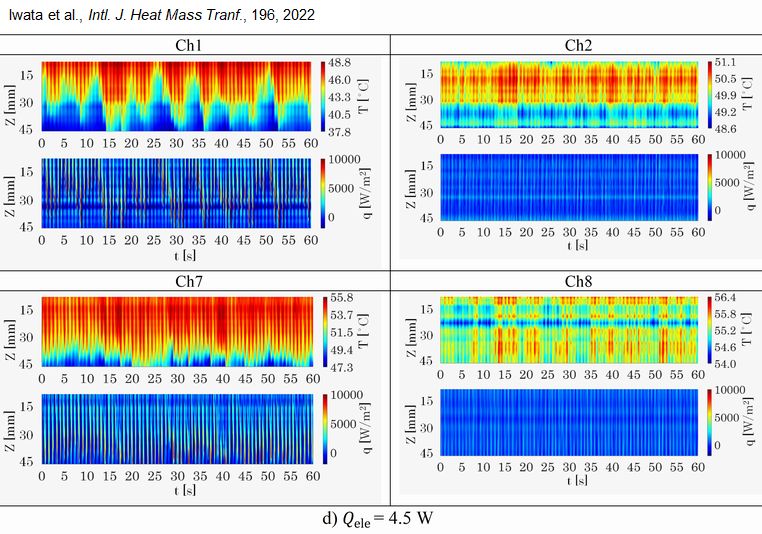 (Temperature and local heat flux of micro-PHP) 19 Jul. 2022Today,
our new paper entitled “Characterization of thermal behavior of a micro
pulsating heat pipe by local heat transfer investigation” has been published in
the online edition of International Journal of Heat and Mass Transfer. The
paper has been published as Golden Open Access in accordance with MSCA's rule
of disseminating research results widely. Anyone can download it free of charge
via the link below.
https://authors.elsevier.com/sd/article/S0017931022006731 |
POTPLOS appeared in Calyos news 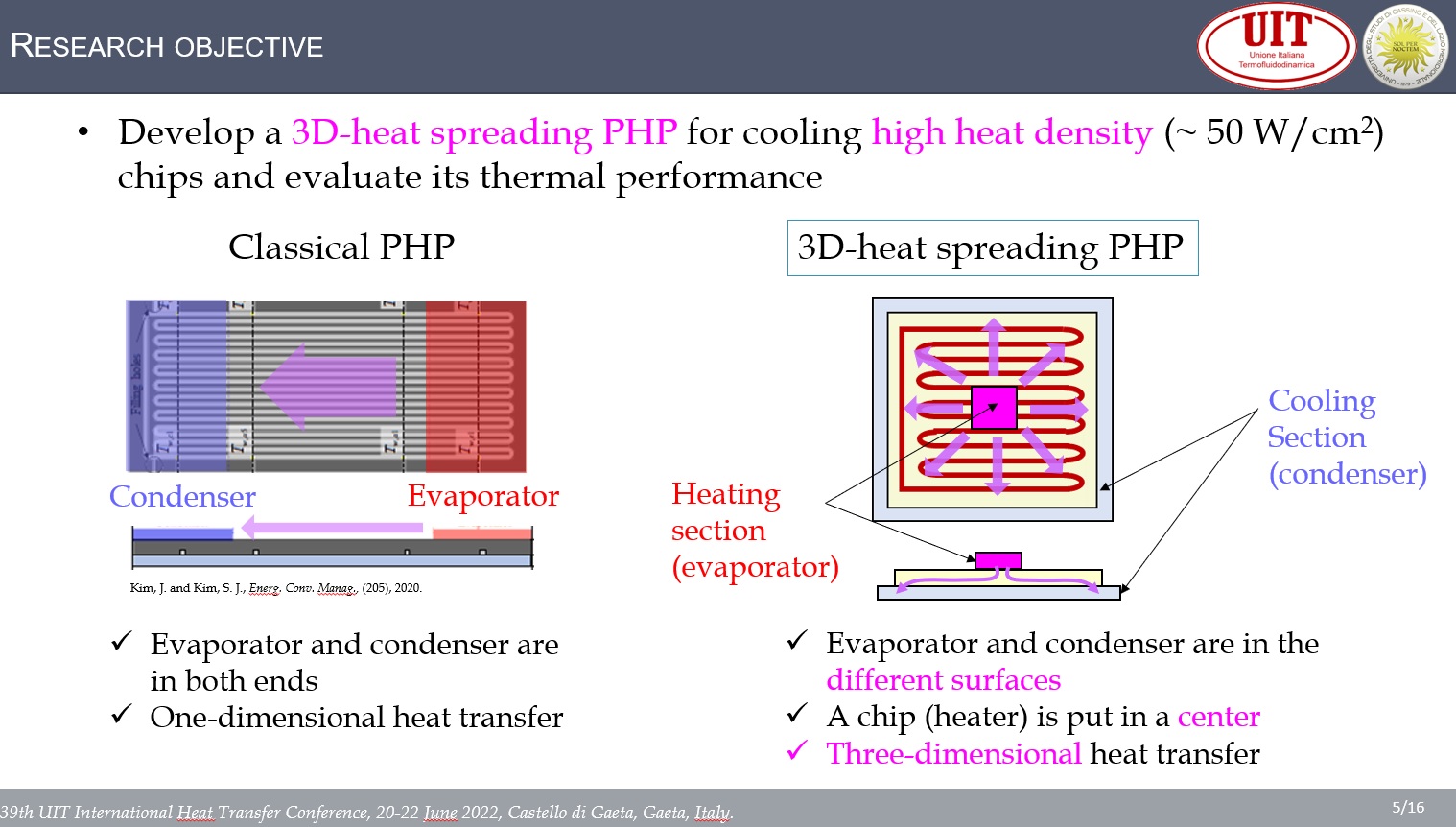 (one slide of presentation in Gaeta) 11 Jul. 2022The
presentation made at the UIT conference in Gaeta is the result of tests carried
out with Calyos colleagues in October 2021 and March 2022. The object was a
flat PHP for heat spreader. Typical PHPs have an evaporator and a condenser at
both ends and heat is transferred in a one-dimensional (1D) direction, but our
PHP is designed to be used with the heat in the centre of one side and the
condenser on the other side, i.e. in a 3D direction. News with POTPLOS link was
posted on Calyos website.
https://www.calyos-tm.com/news/university-of-parma-calyos-paper |
Dominant frequency 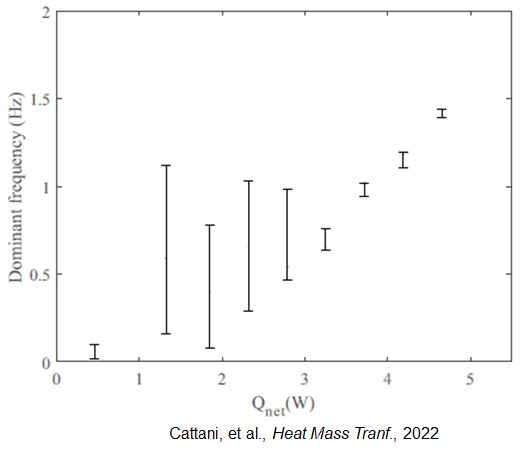 (Dominant frequency) 04 Jul. 2022The
image shows the 95% confidence intervals of dominant frequency values for the
entire device as a function of heat power input. The dominant frequency
increases along the increase of power input, which is a typical behavior of
PHPs. The dominant frequency of 1~1.5 Hz is also reported in several past
studies of PHPs regardless the tube/channel diameter.
|
Frequency analysis of temperature data 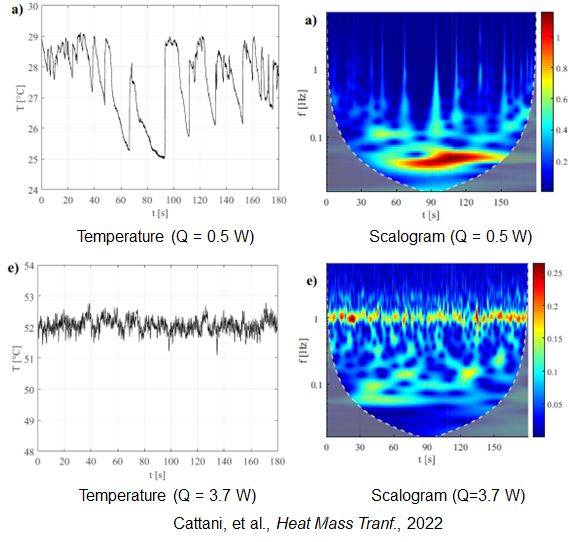 (Temperature history and scalogram) 27 Jun. 2022Frequency
analysis was performed on the temperature measured by the IR camera to
investigate oscillatory behavior of the PHP. The left two figures show 3-minutes-temperature
histories at the low (0.5 W) and high (3.7W) power inputs. t. Frequency
analysis resulted in the scalograms shown in the figure on the right. The
scalogram is defined as the power connected every frequency over the test
interval. At 3.7W, the dominant frequency clearly appears around 1 Hz.
|
Thermal resistance of each turn  (Thermal resistance of each turn of micro-PHP) 12 Jun. 2022The
thermal resistance of each turn was calculated from the condenser temperature
measured with an infrared camera (see the right figure). The PHP has seven
turns, as shown on the left. The resistance of the end turns, i.e., turns 1 and
7, was found to be 1.5 to 2 times higher than the other turns. This is presumably
due to the fact that the internal volume of the manual valve exceeds the volume
of the PHP body. The valve acted as a liquid tank and buffered the fluid oscillations.
|
Temperature measurement by IR camera
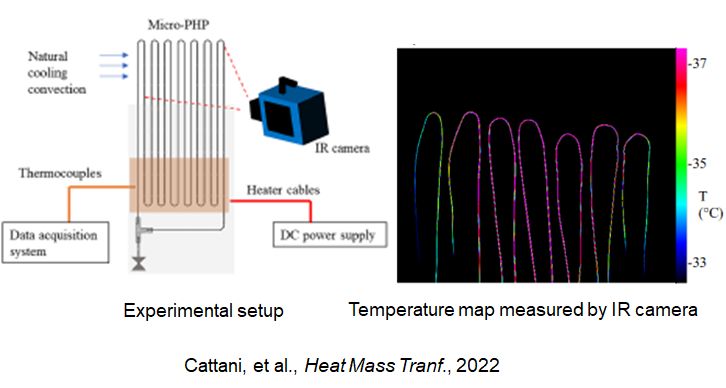 (Infrared measurement) 06 Jun. 2022The
temperature of the condenser was measured with a high-resolution, high-speed
infra-red (IR) camera. Although temperatures are commonly measured with
thermocouples in PHP research, it is not easy to capture the behaviour of PHPs
by themselves. Therefore, visualization experiments using PHPs made of
transparent materials such as glass have been widely conducted. In this study,
the thermal behaviour was visualized using an infrared camera without using
glass, as shown in the diagram on the right.
|
Micro-PHP 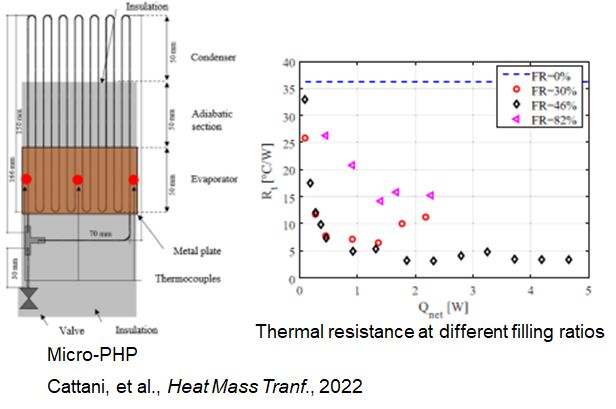 (Micro-PHP) 01 Jun. 2022Our
paper deals with a micro-PHP which consists of stainless-steel tubes with an
inner diameter of 0.32 mm. (Generally, PHPs with a diameter of less than 1mm is
called a micro-PHP.) HFC-134a was charged as a working fluid, at different
filling ratio of 82%, 46%, and 30%. The PHP was tested in the bottom-heat
vertical orientation (see left image). The optimum filling ratio in terms of
thermal resistance was 46% (see right image).
|
Our paper published online! 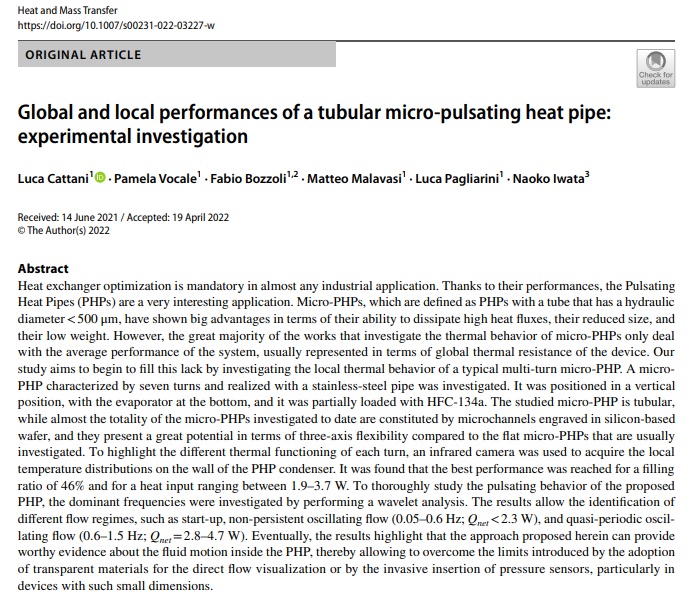 (Paper published online) 23 May 2022Our
paper 'Global and local performances of a tubular micro-pulsating heat pipe:
experimental investigation' has been published online in Heat and Mass
Transfer. Thanks to the cooperation of the University, it is open access, and
anyone can download it free of charge via the link below. The paper reports the
results of temperature measurements and frequency analysis of PHPs using an
infrared camera. Further details will be presented in future pots.
https://rdcu.be/cOaCE |
Second on-orbit experiment of PHP 3 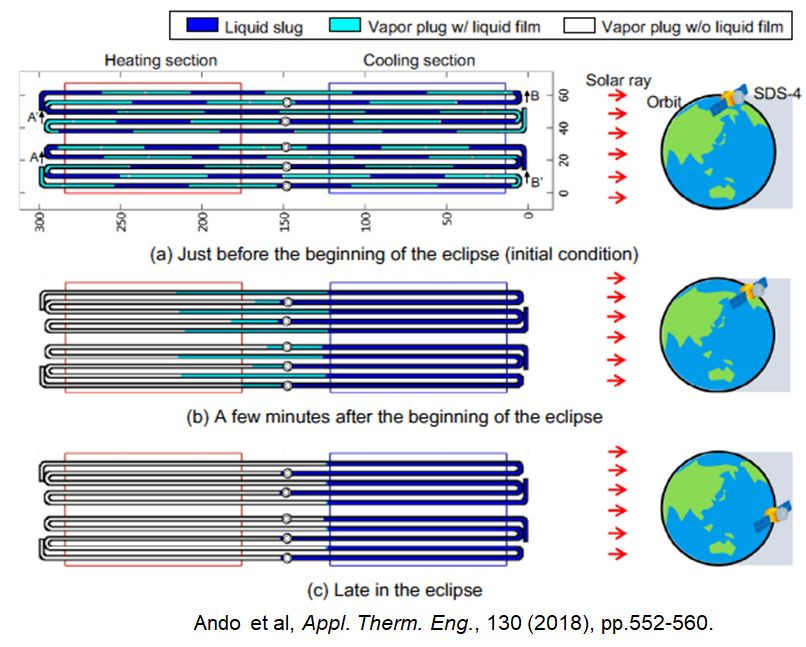 (Temperature history of PHP in orbit) 20 May 2022The
PHP functioned successfully, cycling between periods of operation and
non-operation (the image shows a typical temperature cycle in orbit). Ando et al.
report that no degradation was observed after approximately four years. In
2019, seven years after launch, ownership of the SDS-4 satellite was
transferred from JAXA to a private company; the PHP would still be flying in
orbit today.
|
Second on-orbit experiment of PHP 4  (Fluid distribution of PHP in orbit) 14 May 2022The PHP
showed difficulties in start-up just after the eclipse. (SDS-4 orbits the Earth
in 90 min, 30 min in which are in eclipse.) Ando et al. state that this was presumably
caused by localization of liquid in the condenser due to cooling during the
eclipse, as shown in the image. They activated a backup heater on the condenser
to distribute the fluid to the evaporator, and the PHP was recovered its
function.
|
Second on-orbit experiment of PHP 2 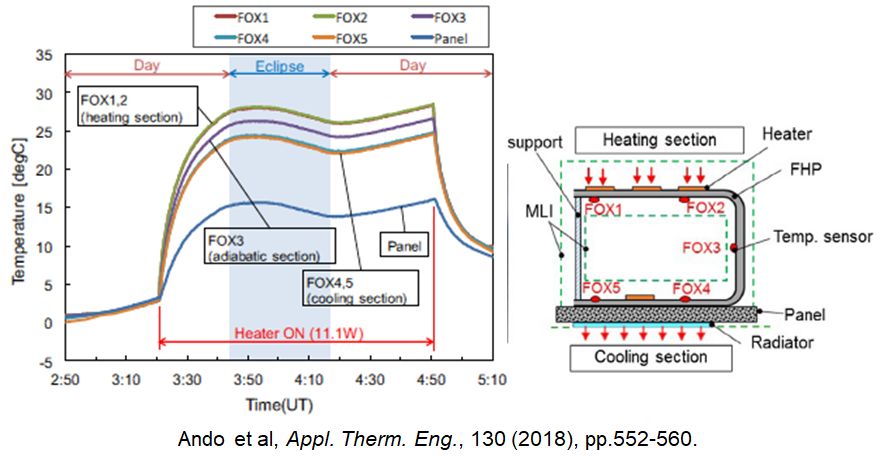 (Temperature history of PHP in orbit) 10 May 2022The
PHP operated successfully in orbit. The image shows the temperature history at
power input of 11 W. Immediately after the heater was turned on, the all the temperatures
including the condenser rose and the temperature difference between the
evaporator and the condenser was less than 20 degC. This indicated the PHP was
successfully operating. (According to the paper, the difference would be 110
degC if PHP did not operate.)
|
Second on-orbit experiment of PHP  (SDS4 and onboard PHP) 06 May 2022Ten
years after PHP’s first spaceflight, JAXA (Japan Aerospace Exploration Agency)
launched a 50kg-class small satellite, SDS-4, in which a new PHP was mounted. The
PHP was U-shaped with five turns. Notably, it had a check valve in the
adiabatic section of every turn. R-134a was charged same as the first
spaceflight PHP, with the filling ratio of 45 %.
|
First spaceflight (in orbit) PHP 3 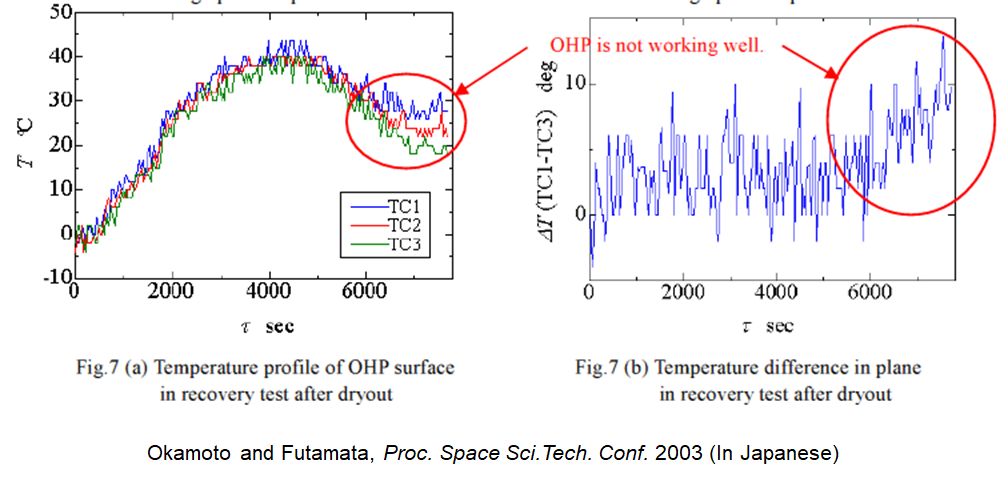 ( Temperature history of PHP in orbit) 02 May 2022One
day after the PHP dried out, the heat load was applied again in order to
recover. However, the temperature history (see the image) did not show its
successful recovery. The paper reports that the PHP did not show this behavior
on the ground. This suggests that PHPs might lose their function fatally when
they dry out in orbit.
|
First spaceflight (in orbit) PHP 2  ( Temperature history of PHP in orbit) 27 Apr. 2022In
orbit, the PHP onboard μ-CubeSat operated at the low
power input of 2.5 W ~ 5 W, as the temperature difference between the evaporator
and the condenser is small (see the top two figures). However, with higher
power input to the heater, the difference rapidly increased up to more than 20 degC
as bottom two figures show, indicating that PHP dried out (=stopped operating).
|
First spaceflight (in orbit) PHP 1 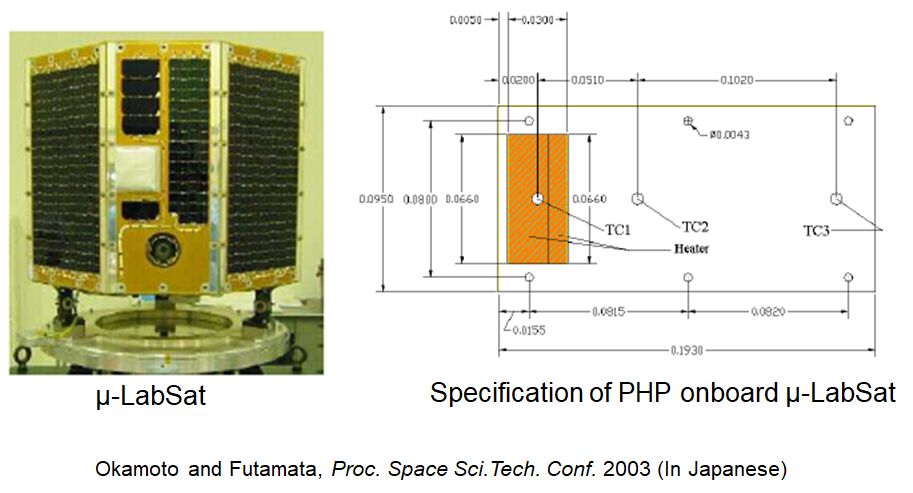 (
μ-LabSat and onboard PHP) 23 Apr. 2022To my
knowledge, two PHPs have been launched to date, both on small Japanese
satellites. The world’s first PHP to fly in space (probably) was on board the
μ-LabSat, launched in 2002 into a sun-synchronous sub-recurrent orbit at an
altitude of 800 km; the PHP was a 95 mm x 193 mm flat plate with 1.5 mm x 1 mm
channels machined at a 2 mm pitch, 60 % filled with R134a.
|
Ammonia PHP 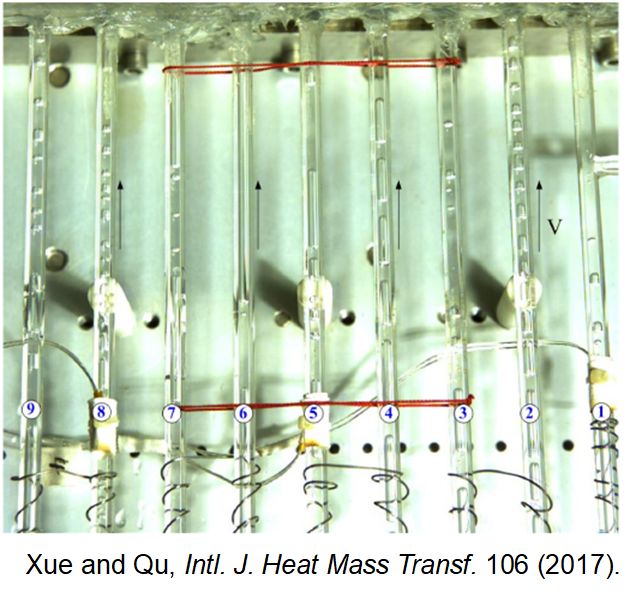 (Ammonia PHP)
18 Apr. 2022So
far, two research groups in China and Bangladesh have reported experimental
results with ammonia PHP: Xue and Qu of the China Academy of Aerospace
Aerodynamics have tested PHP made of glass. Their results show typical
characteristics of PHP, such as the transition from slug flow to annular flow.
They also stated that ammonia PHP has a smoother start-up than other fluids due
to less superheating in the evaporator.
|
Why is ammonia PHP rare? 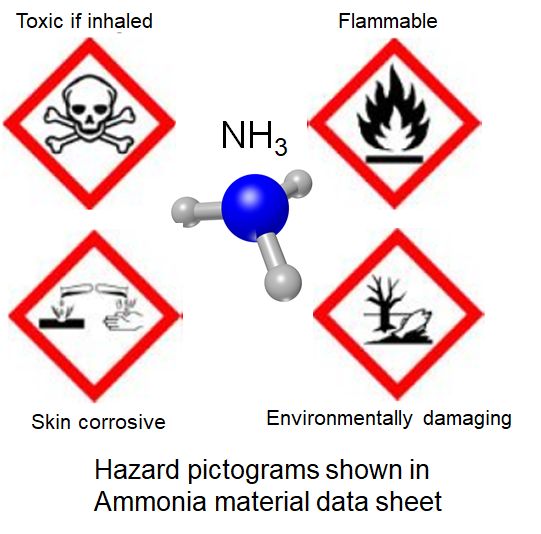 (Hazard pictograms shown in ammonia material data sheet) 13 Apr. 2022
On the
contrary to the conventional heat pipes and loop heat pipes, Ammonia PHP has
rarely been reported. This is probably due to the fact that Ammonia is
highly toxic and charging with ammonia requires special facility which complies
with regulations. From what I have seen and heard in JAXA, not only charging
but also maintaining the facility requires a lot of effort and cost. The
advantages of PHPs - easy to fabricate with low-cost- will therefore be eliminated,
at least on a laboratory scale.
|
Heat pipes for space application 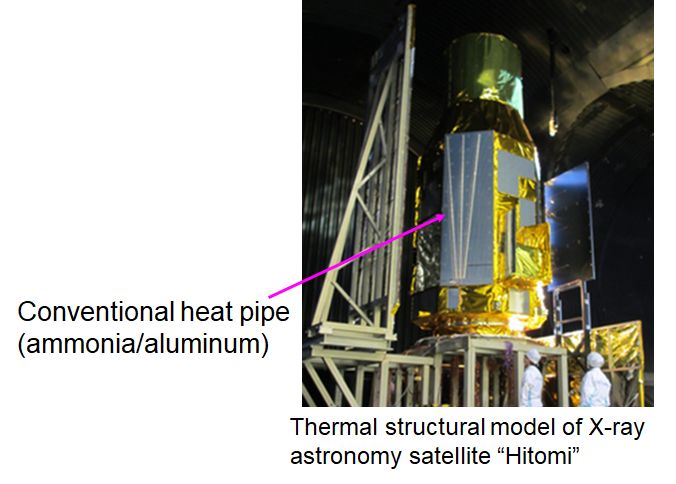 (Heat pipes onborad X-ray astronomy satellite) 07 Apr. 2022
Unlike
heat pipes for terrestrial consumer products, space heat pipes are typically a combination
of aluminum and ammonia. This is because ammonia has an operating temperature range
suitable for space applications especially satellites ( -70 °C ~ 100 °C) and
has excellent thermophysical properties as a heat pipe. The availability of
aluminum, which has a relatively low density among metals, is also important to
minimize launch weight of spacecraft.
|
Copper/water heat pipes 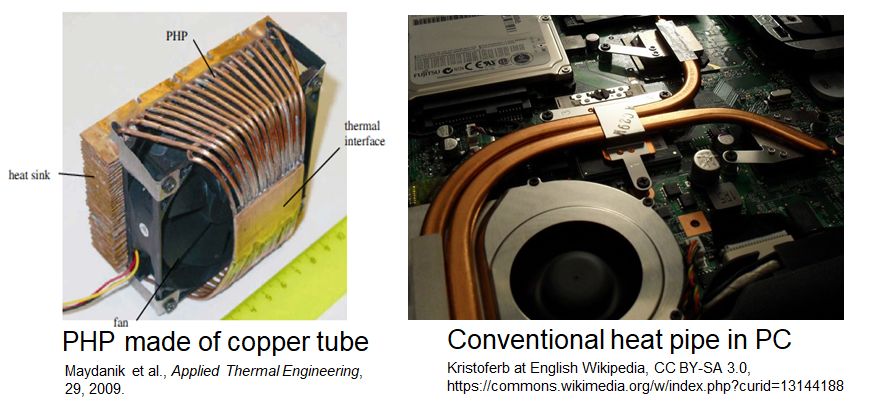 (Copper/water heat pipe) 04 Apr. 2022
Heat
pipes consisting of a combination of copper (container) and water (working
fluid) are probably the most widely used in commercial applications, especially
in computers. The operating temperature of water (typically 25-150°C) is
suitable for cooling electronics, and water has almost optimal thermophysical
properties for heat pipes; in the case of PHPs, the required thermophysical
properties are slightly different, but the combination of water and copper is
also considered preferable for the same applications.
|
Fluid compatibility with tbe/plate material 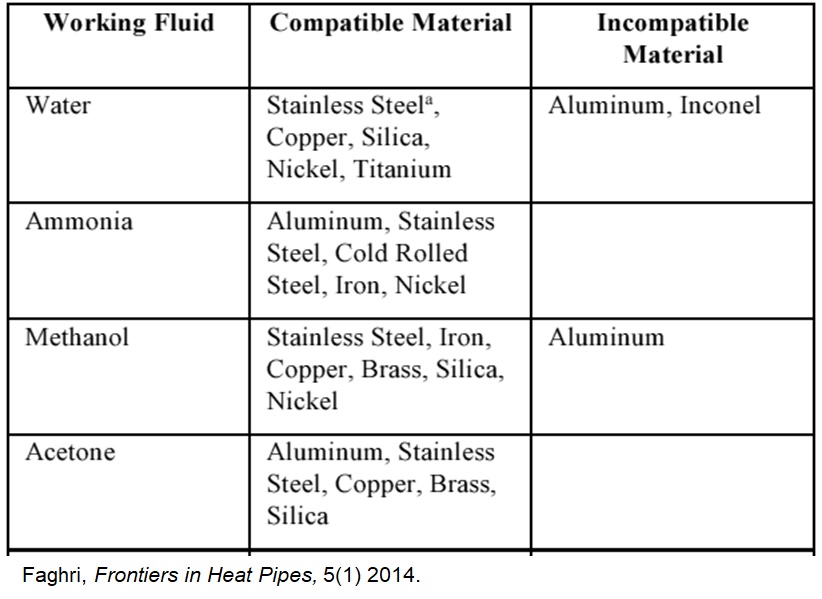 (Fluid compatibility) 29 Mar. 2022
Careful
attention must be paid to the chemical compatibility of the working fluid with
the container material. The use of incompatible materials can cause the chemical
reactions and corrosion. This is true for all types of heat pipes, not just
PHPs. The most widely used material in PHP research has been copper, and water,
acetone and ethanol have been widely used as working fluids in copper tubes or
plates.
|
Surface tension and capillary resistance force 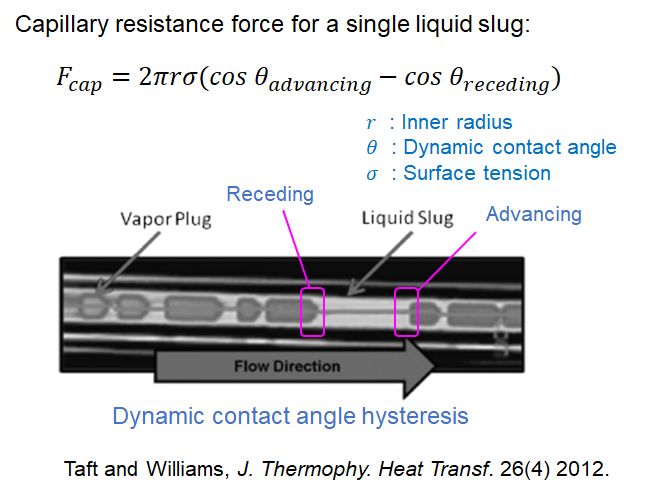 (Capillary resistance force) 21 Mar. 2022
The
previous studies also suggested that high surface tension might have negative
impact on the fluid oscillation. In the slug/plug flow, the receding edge of
the liquid slug has a smaller contact angle than the advancing edge; the difference
is called dynamic contact angle hysteresis. This causes a capillary resistance
force against the flow, which is proportional to the surface tension as shown
in the image.
|
Surface tension and maximum inner diameter 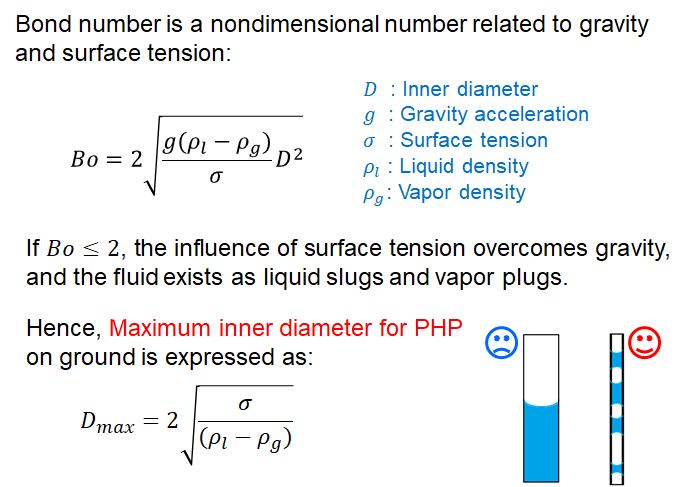 (Maximum inner diameter of PHP) 18 Mar. 2022
Surface
tension is closely related to the definition of the maximum inner diameter for
PHP. The inner diameter must be small enough for the fluid to exist as vapor
plugs liquid slugs under gravitational environment. The maximum diameter is
derived from the Bond number as the image shows. The high surface tension increases
the maximum inner diameter of PHP, which expands the possibilities of tubes/channels
available for PHP.
|
Sensible heat - specific heat 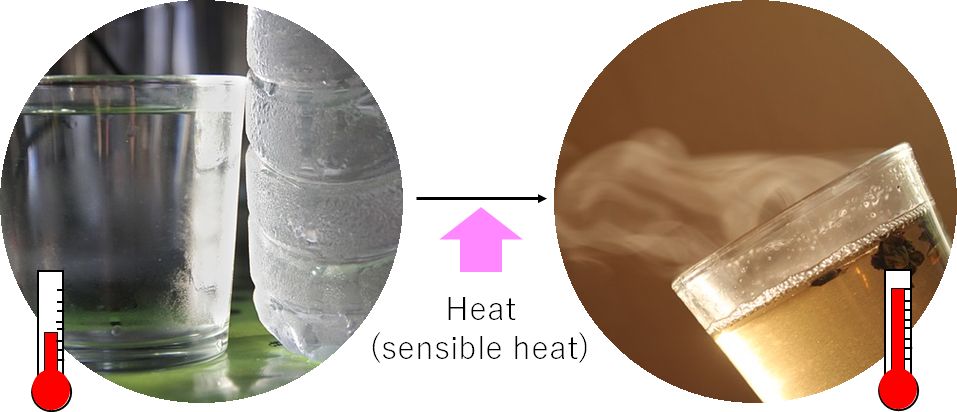 (temperature curve) 11 Mar. 2022
Compared
to classical heat pipes, where latent heat is responsible for heat transfer, in
PHPs some or most of the heat is transferred by sensible heat, especially when
the heat flux in the evaporator is low. It may therefore be desirable to use a
working fluid with a high specific heat to increase the heat transfer.
|
Latent heat  (temperature curve) 11 Mar. 2022
Since
the vaporization induces the fluid oscillation, latent heat is an important
parameter. Generally, low latent heat is desirable because the liquid evaporates
quickly under the same temperature and therefore PHP starts up smoothly. However,
if the heat flux in the evaporator is high, a fluid with a higher latent heat
is preferred for the same reason as in conventional heat pipes, i.e., high
latent heat leads the large heat transfer rate.
|
Viscosity 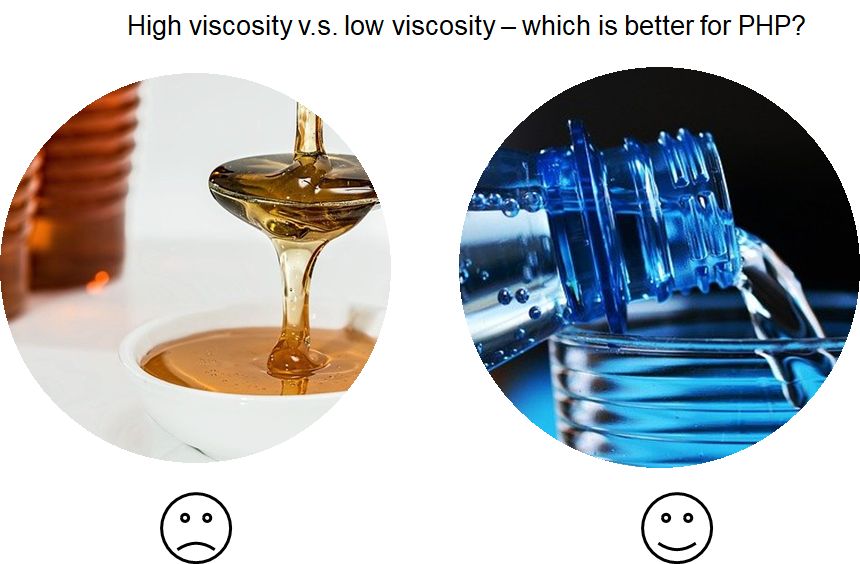 (HIgh viscosity v.s. low viscosity) 03 Mar. 2022
Among
the thermophysical properties of the working fluids, viscosity is one of the
most important for PHP performance. This is because low viscosity reduces shear stress between
the fluid and the inner wall of tube or channel, which reduces pressure drop
and thus improves thermal performance. If the fluid is highly viscous, stable
oscillations may not be maintained.
|
Temperature range  (Suitable temperature range)
28 Feb. 2022The first thing to consider
when selecting a working fluid is the temperature range. It is important that
the fluid exits in a liquid and gas state within that range, i.e., that it does
not freeze and that it does not exceed the critical point. For example, if PHP
is used to cool electronic device, then a refrigerant (fluorocarbon) or alcohol
would be suitable. However, if you are looking for a easier and less toxic fluid,
water would also be a candidate, though its suitable range is slightly higher
than room temperature.
|
POTPLS on QuBitv's UniPR Channe! 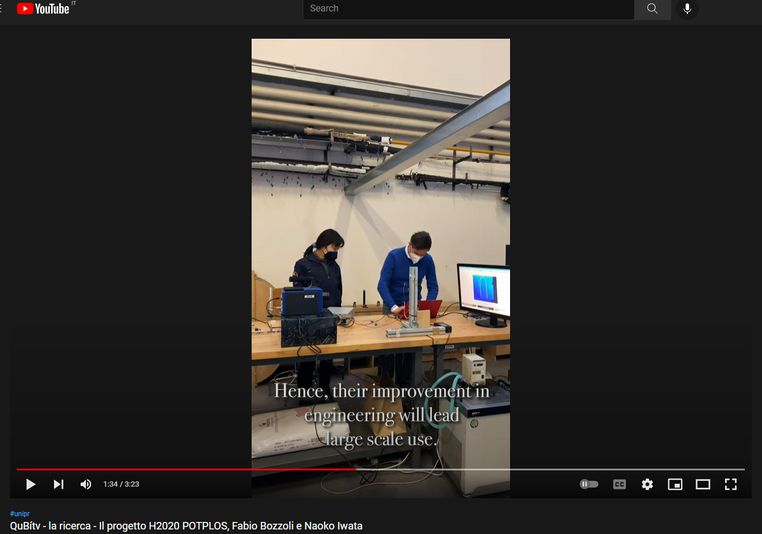 (POTPLOS on UniPR Channel)
25 Feb. 2022Fabio
and Naoko appeared on QuBitv to show POTPLOS’s activity.
https://www.youtube.com/watch?v=vrQWGZBOfaw |
Working fluid of PHP 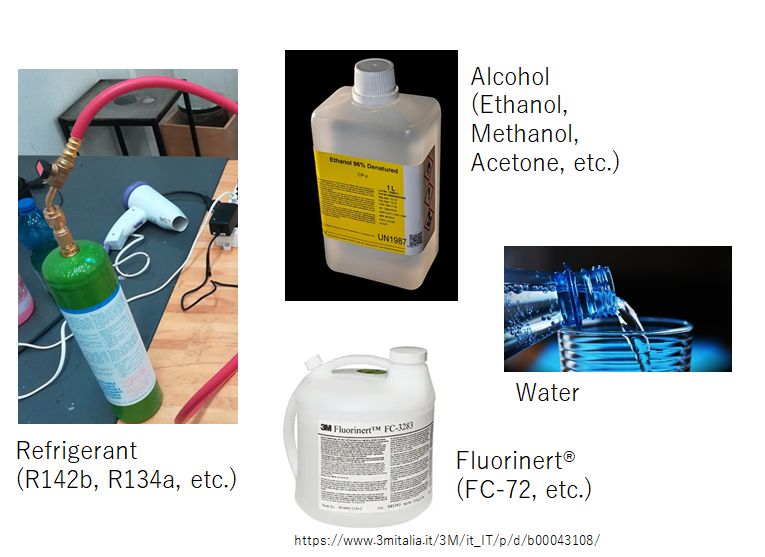 (Typical working fluids)
24 Feb. 2022What
kind of fluids are charged in PHP? From this post, I will focus on the working
fluid. The image shows typical fluids in PHP. Water and Ethanol have been
widely used since the early stages of PHP research. Refrigerant, especially
hydrofluorocarbons, have also used in several studies because they provide
suitable temperature range and pressure. Other commonly used fluid includs Fruorinert(R), which developed by 3M.
|
Liquid thin film #7 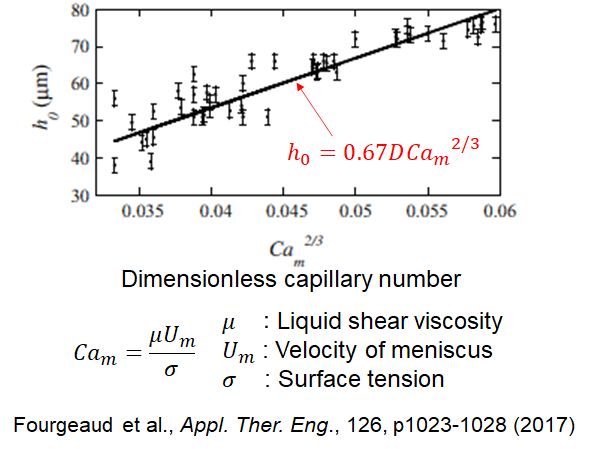 (Film thickness reported in Fourgeaud et al.'s study) 15 Feb. 2022
As a
result of measurement of thin-film thickness, Fourgeaud et al. reported that
the thickness of the liquid film which is connected to the meniscus was between
40 and 80 micrometres. They also highlighted that the thickness was presented
as a function of dimensionless capillary number Ca_m, which is expressed by the
equation in the image. This is derived from the theory that the film thickness
is controlled by the balance between the viscos friction and surface tension in
the meniscus.
|
Liquid thin film #6 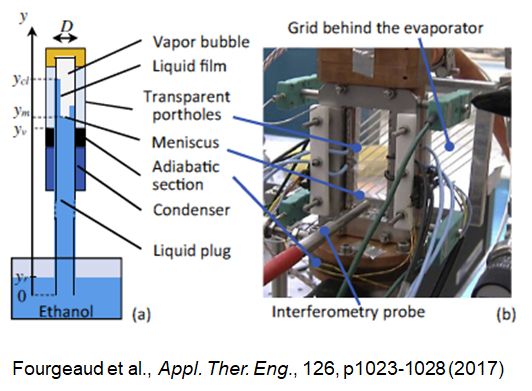 (Experimental setup of Fourgeaud et al.'s study) 11 Feb. 2022
What
is the liquid film thickness? Several past studies predicted the thickness of
several tens of micromillimeters. It is not easy to measure the thickness because
it is very thin, but some researchers have tried. For example, Fourgeaud et al.
used spectrometer. They
sent white light from a probe (see the image) perpendicular to the film surface.
The thickness was deduced by observing the interference of the reflected light
from two interfaces: the film and the vapor, and the film and the inner wall.
|
New video on single-loop PHP released 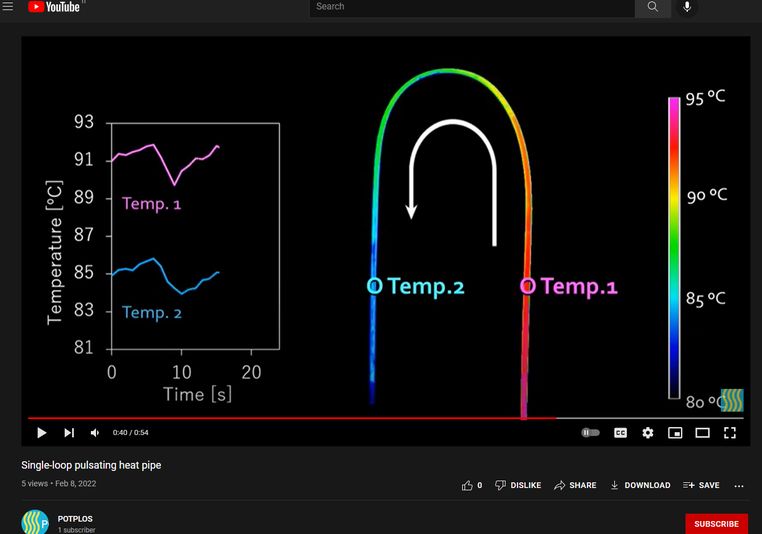 (video on POTPLOS channel) 08 Feb. 2022
A
new
video has been released on POTPLOS Channel on YouTube. In the video, a
single-loop PHP that is a simplest type of PHP is featured. The
video shows an infrared video of a bottom-heated, single-loop PHP condenser.
https://www.youtube.com/watch?v=1LyvTqRIN2s |
Liquid thin film #5 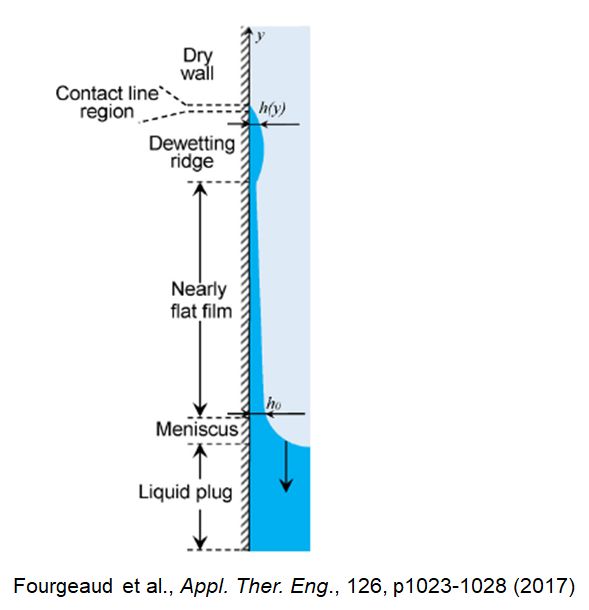 (Thin-film model) 07 Feb. 2022
Recently,
a liquid thin film model in which more actual phenomenon is reflected has been
proposed. The image shows the model proposed by Fougeaud et al. In their model,
dewetting ridge is considered at the edge of the film. Dewetting is a process
in which a liquid thin film raptures on a substrate and forms a droplet.
|
Liquid thin film #4 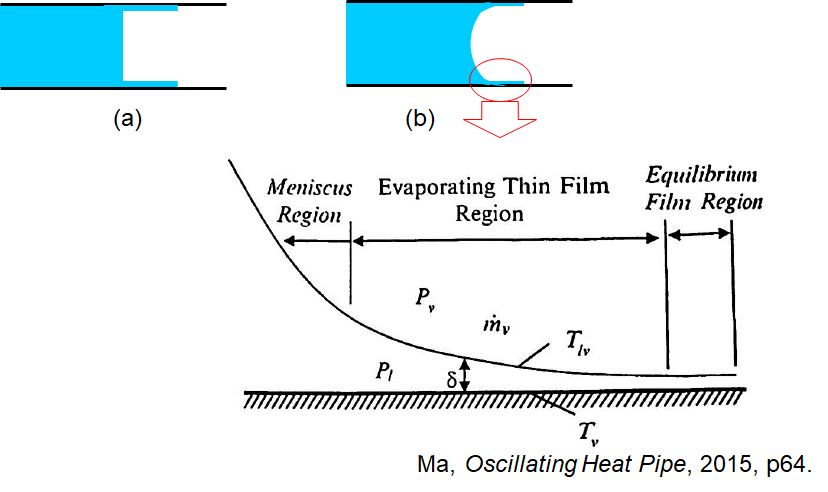 (Thin-film model) 04 Feb. 2022
In
contrast to the simplest thin-film model as shown in image(a), some microscopic
models close to the actual film geometry have been proposed. In
general, thin films are considered to be smoothly connected to the edge of the
meniscus (image (b)). Ma [2015] stated that the evaporation takes place at the
curvature region between the meniscus region and the equilibrium region where
the film becomes flat.
|
Liquid thin film #3 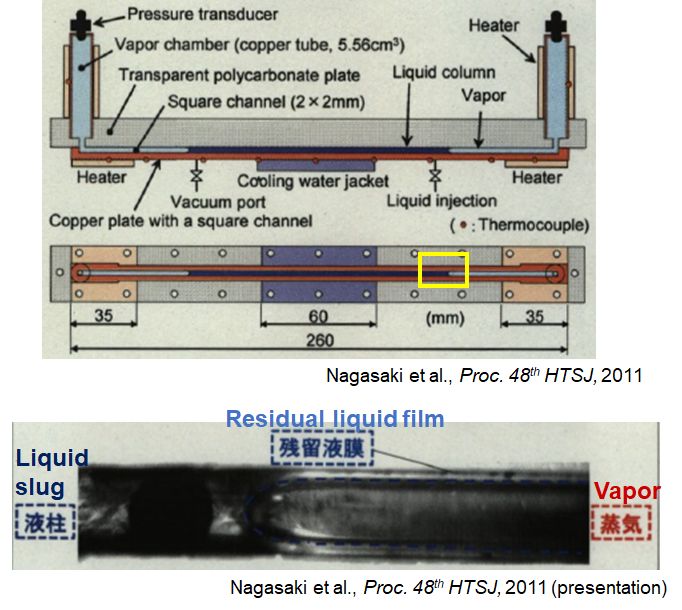 (experimental setup of Nagasaki et al.'s study) 27 Jan. 2022
Nagasaki
et al. conducted visualization experiments using a single straight channel (see
above image). Self-excited oscillations of a liquid slug between the two ends
were observed. They succeeded
in capturing the liquid film left on the trailing edge of the liquid slug when
the slug moves (see bottom image), which was assumed in Zhao and Faghri’s model
introduced in the previous post.
|
Liquid thin film #2 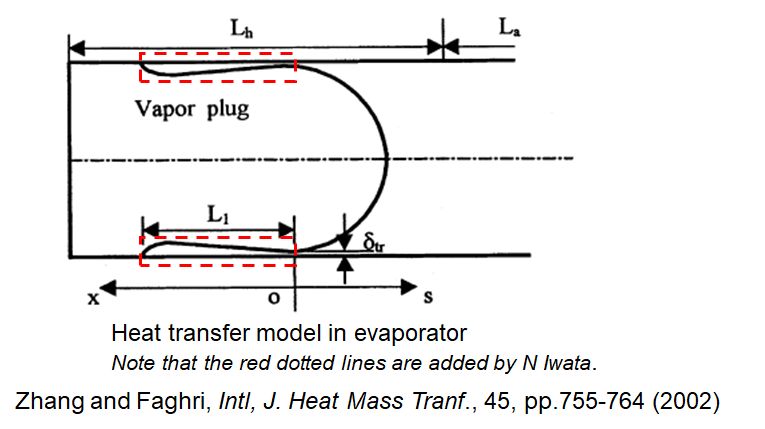 (Zhang and Faghri's Heat transfer model) 22 Jan. 2022
Nowadays, the liquid thin films are commonly considered
in PHP modelling, but this was not the case not in the very early stages of PHP
research (up to the early 2000s). Zhang and Faghri proposed a PHP model with
thin film where evaporation and condensation occur. They assumed the film (shown
by red dotted lines) is left on the trailing edge of the liquid slug when the
slug moves.
|
Liquid thin film #1 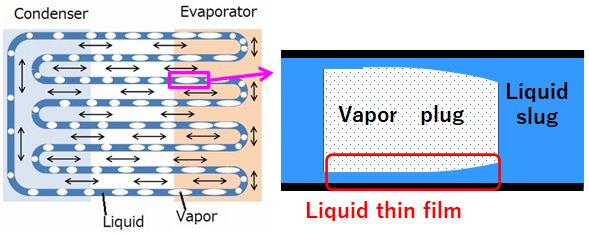 (Liquid thin film) 17 Jan. 2022
One of the keys to PHP modelling is how to deal
with liquid thin film. As we have shown in the previous posts, the films are
closely related to evaporation and condensation, which are linked to the
driving force of the oscillation as well as to the heat transfer. How are the
thin film formed? Under what conditions? What shape does it have? A number of
studies have been carried out to try to answer these questions.
|
Model of self-excited oscillation #7 - frequency 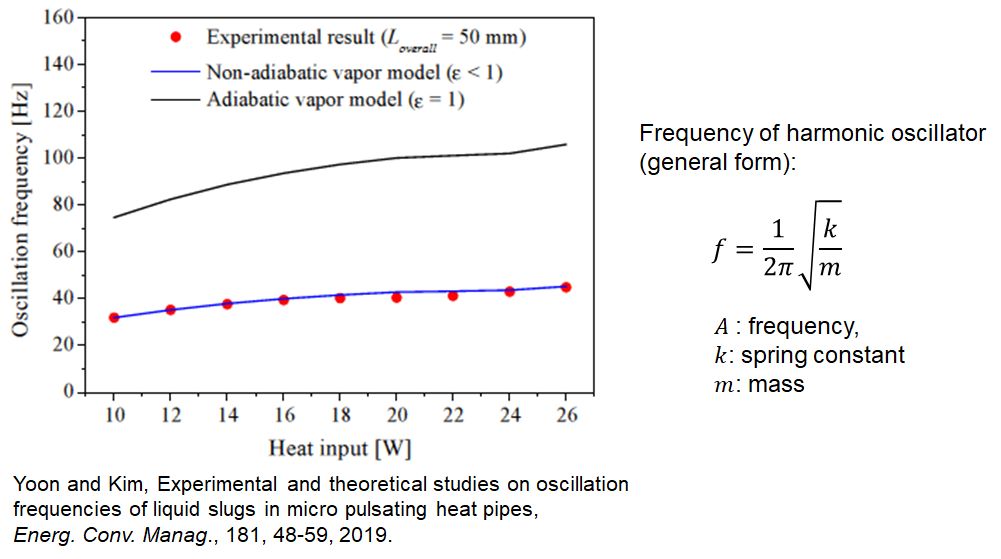 (Frequency) 09 Jan. 2022
The vapor-spring-mass model was evaluated for the
vibration frequency and agreed with the experimental results [Yoon and Kim,
2019]. The spring constant for the harmonic oscillator was derived from the
continuity and momentum equations. When the mass change due to the phase change
is taken into account, the simulation results agree well with the experimental
results, and when the mass change is neglected, the results are overpredicted.
|
Model of self-excited oscillation #6 - driving force 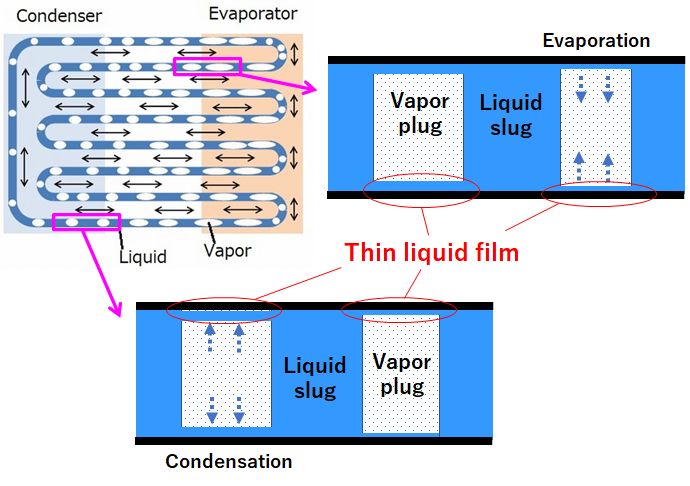 (driving force) 30 Dec. 2021
What is the driving force behind the oscillation? Similar
to the model shown in the previous posts, the latent heat is thought to cause
the force in the mass-spring model [Peng et al., 2014]. Over the last two
decades, a number of studies have suggested that evaporation and condensation occur
in thin liquid films formed on the inner wall surface of the tube (or channel).
|
Model of self-excited oscillation #5 - harmonic oscillation 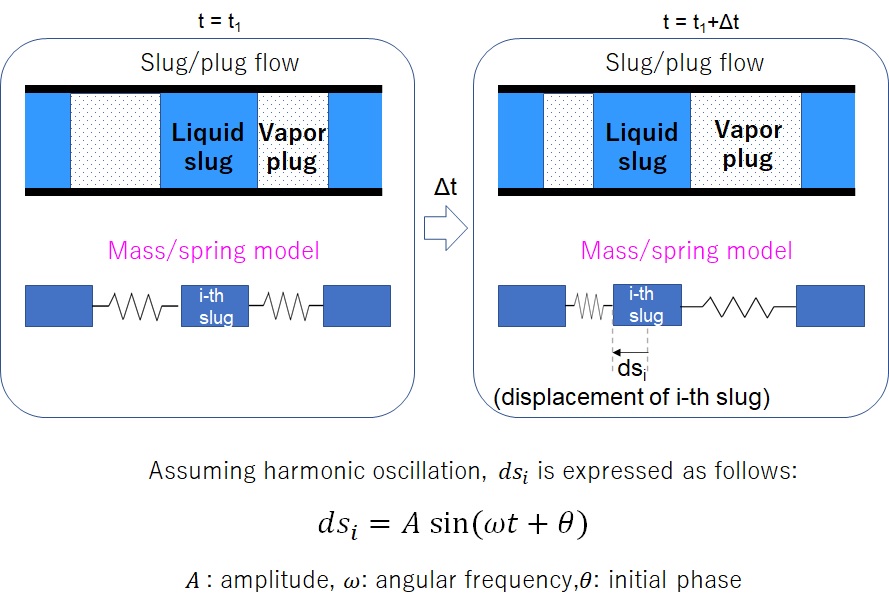 (harmonic osciilation) 28 Dec. 2021
In the mass-spring model for PHP, generally, liquid
slugs are assumed to oscillate harmonically. Harmonic oscillation is the
periodic motion of an object constrained by an ideal spring with a restoring
force proportional to the displacement. One of the classical solutions of the momentum
equation for harmonic oscillation is expressed by a trigonometric function, as
the equation in the image shows.
|
Merry "pulsating" Christmas! 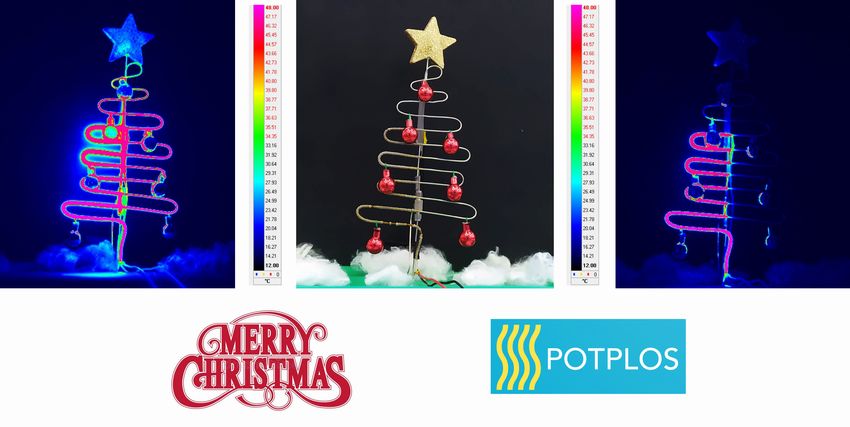 (Infrared and visible-light images of Xmas tree PHP)
"PHP
in Christmas-tree shape"
Left: temperature map for filled PHP at 60 W power input Centre: visible-light image Right: temperature map for empty PHP at 10 W power input |
UniPR press release 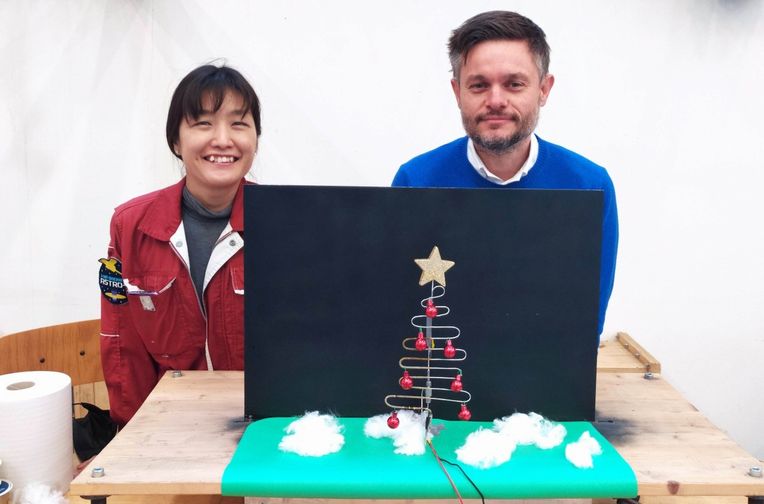 (Fabio and Naoko with Xmas tree PHP)
Three big news:
1) we got an award; 2)we are on the University page; 3) we made a pulsating Christmas tree. Chose the one you prefer! Nuove tecnologie per lo scambio del calore: “Don Ernst Award” al progetto POTPLOS dell’Universitą di Parma | Universitą degli Studi di Parma (unipr.it) |
Model of self-excited oscillation #4 - mass/spring model 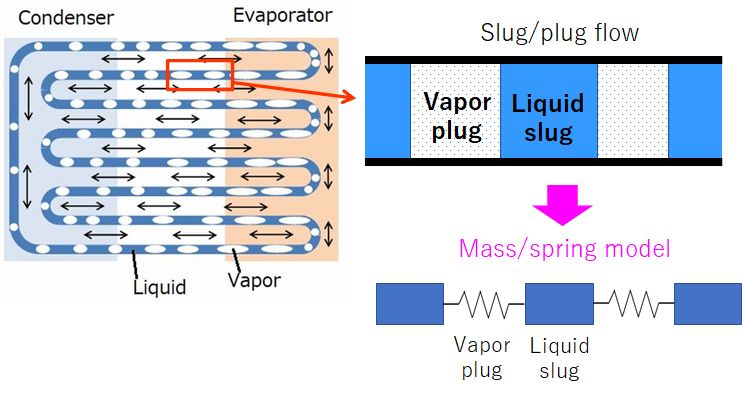 (Schematic of mass/spring model)
The mass/spring model is the relatively new one
compared to the two models presented so far. Peng et al.* proposed nonlinear
thermomechanical finite-element model, considering the liquid slug, regarded as
mass, to oscillate harmonically due to the spring effect of the vapor plugs on
both sides.
* Peng et al., Intl. J. Heat Mass Tranf., 69, 2014. |
New video released on POTPLOS channel!  (Thumbnail of new video)
In new video, we show the start-up of PHP taken by
infrared camera:
https://youtu.be/lYcWa1dmQcs |
Model of self-excited oscillation #3 - wave equation 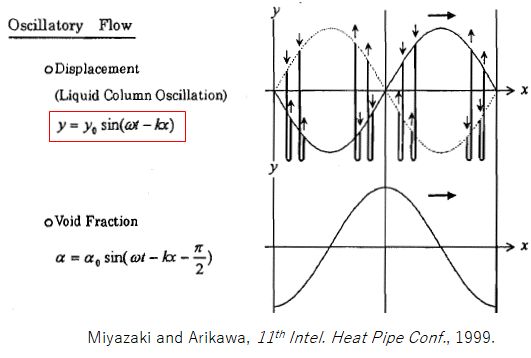 (Displacement expressed in terms of a wave equation)
As a result of visualization experiment, Miyazaki
and Arikawa reported that the position of vapor-liquid interface in each
channel changed continuously and the overall result was a waveform. They
expressed the displacement of the liquid slug in terms of a wave equation. The
following YouTube video shows a fluid oscillation similar to what they
observed.
https://www.youtube.com/watch?v=RmB4mJpmW4A |
Model of self-excited oscillation #2 - reciprocal self-exciting effect between pressure and void fraction 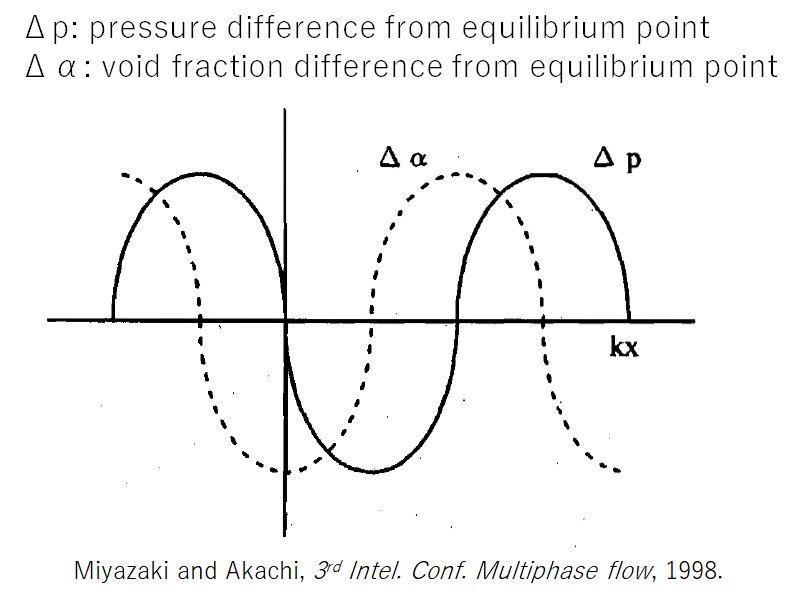 (Pressure difference and void fraction difference of PHP)
The pressure rises in the channels/tubes where the
void fraction is small and drops in those where the void fraction is large.
This pressure difference among channels causes oscillating flow. The reciprocal
self-exciting effect between the pressure (p) and void fraction (α) is shown as a waveform of Δp and Δα with a different phase of 90 degrees.
|
Model of self-excited oscillation #1 - interaction of pressure and void fraction  (Fluid distribution and non-uniforn void fraction of PHP)
Some
researchers have proposed different PHP models to the one presented so far here.
In 1998, Miyazaki and Akachi presented an analytical model of self-excited
oscillation in which reciprocal excitation between pressure and void fraction
is assumed. They proposed that the pressure difference among turns arises from
the non-uniform distribution of void fraction.
|
Modeling of PHP #9 - simulation result 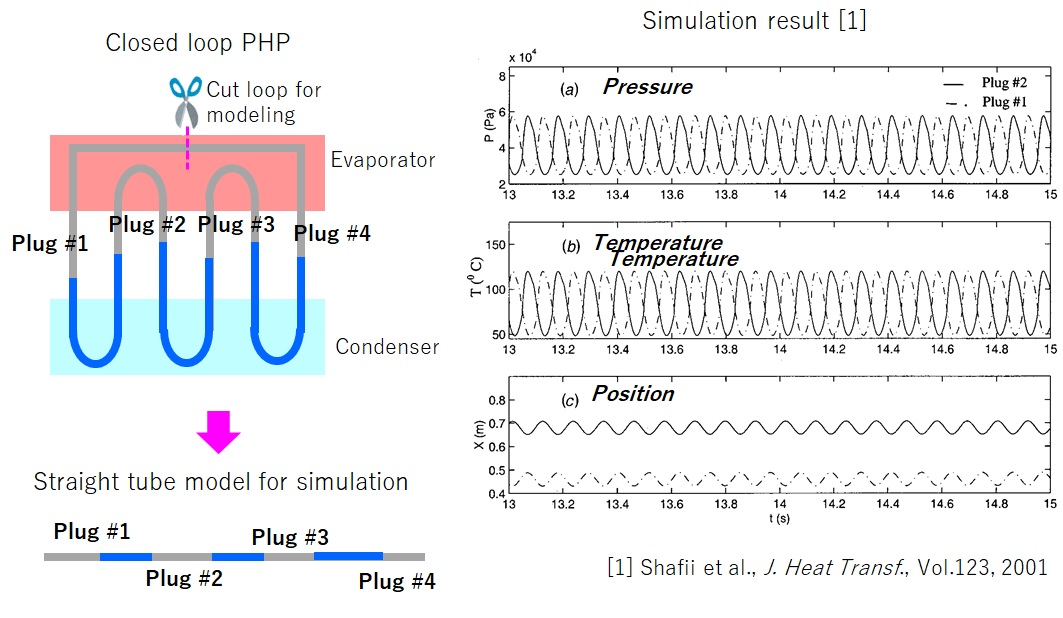 (Simulation result of closed loop PHP)
Shaffi
et al. reported the numerical simulation result of open and closed-loop PHP in
the paper in which they presented their modelling [Shafii et al., 2001]. Since
their model did not consider the tube bends, the closed-loop PHP was assumed to
be a straight tube. The result of simulation shows the cyclic pulsation of
temperature, pressure, and the position of the vapor plugs.
|
Modeling of PHP #8 - discretization 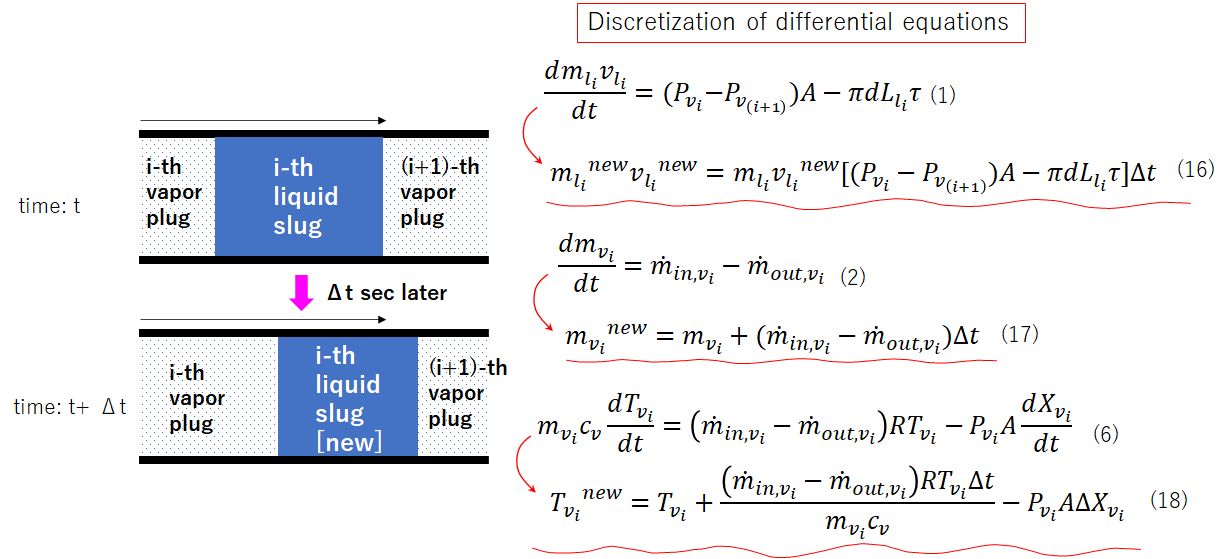 (Discretization of differential equations)
We now
have several differential equations. It is difficult to solve these
analytically to get an exact solution, so we need to use a computer to obtain a
solution by numerical simulation. In order for the computer to do the
calculations, each equation needs to be expressed in terms of basic arithmetic
operations. Therefore, we discretize the differential equations in small time
steps Δt. Equations (1), (2) and (6) are replaced by equations (16), (17) and
(18) respectively.
|
Modeling of PHP #7 - total heat transfer 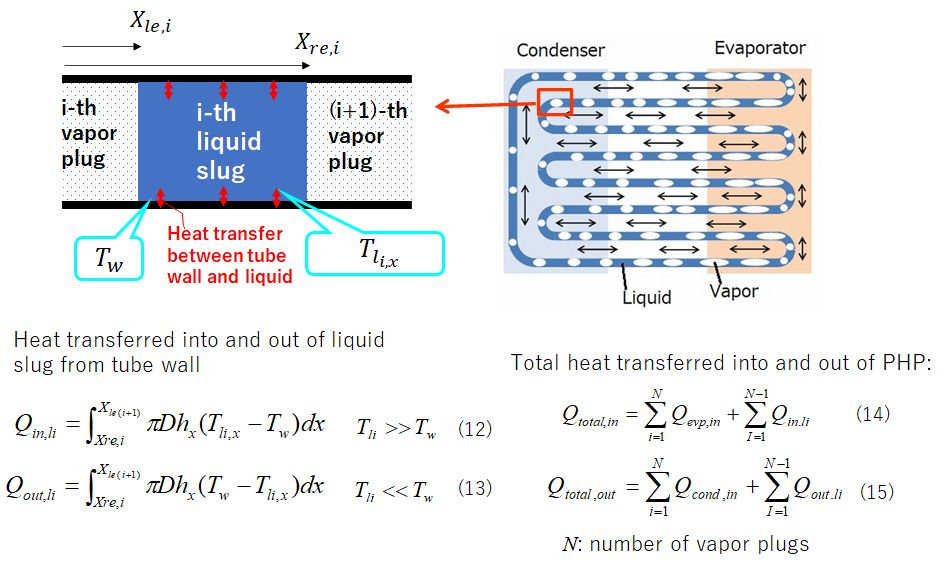 (total heat
transfer)
The
heat transferred into and out of the liquid slug from tube wall by single-phase
heat transfer is expressed as equations (12) and (13), respectively. Adding all
the single-phase heat transfer between the liquid slugs and tube wall and the
heat transfer due to phase change, finally, the total heat transferred into and
out of the PHP is given by equations (14) and (15).
|
Modeling of PHP #6 - single-phase heat transfer 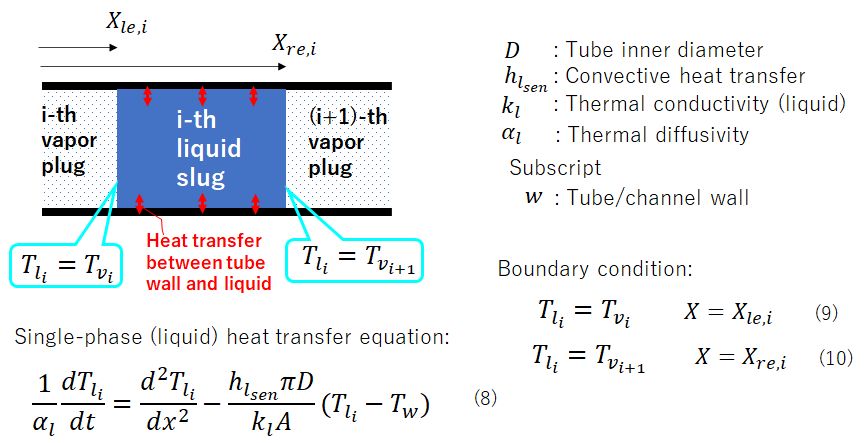 (single-phase heat
transfer)
The
single-phase heat transfer between the tube wall and liquid is obtained by
solving the energy balance equation for a liquid slug, which is shown as
equation (8) in the figure. The heat transfer coefficient h_lsen has to be
calculated properly depending on the Reynolds number of the flow. The boundary
conditions at the both liquid-vapor interface are given as equation (9) and
(10): the vapor and liquid temperature is equivalent at the interface.
|
Modeling of PHP #5 - heat transfer 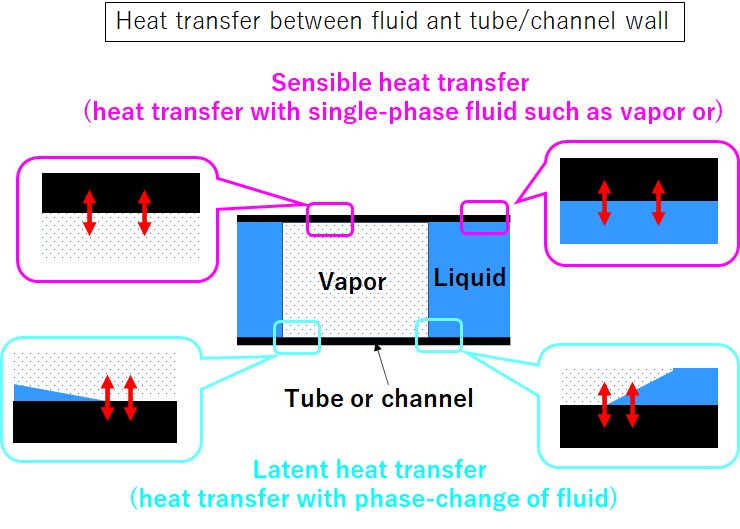 (heat
transfer between fluid and tube/channel wall)
Now we
are trying to model heat transfer, which in PHP is of two types: latent heat
and sensible heat. This could be one of the unique features of PHP. In general,
conventional heat pipes transport heat only by latent heat. In PHP, the phase
change acts as the driving force of the self-excited oscillation and heat
transfer, but the single-phase heat transfer is also important.
|
Modeling of PHP #4 - energy balance 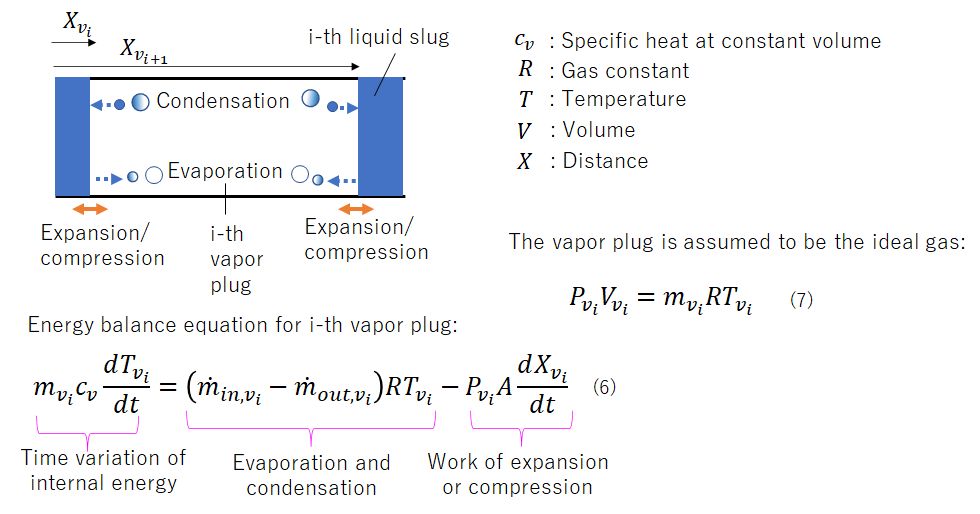 (Energy balance equation)
The
energy balance equation for i-th vapor plug is expressed as in equation (6)
taking into account two terms: phase-change (evaporation and condensation) and
work of expansion or compression. Assuming that the vapor plug is the ideal
gas, its pressure is calculated using the ideal gas law, as equation (7). Note
that the pressure calculated by eq. (7) must be lower than the saturation
pressure at the temperature calculated by eq. (6), because the ideal gas law is
no longer valid if the former exceeds the latter.
|
Modeling of PHP #3 - mass balance 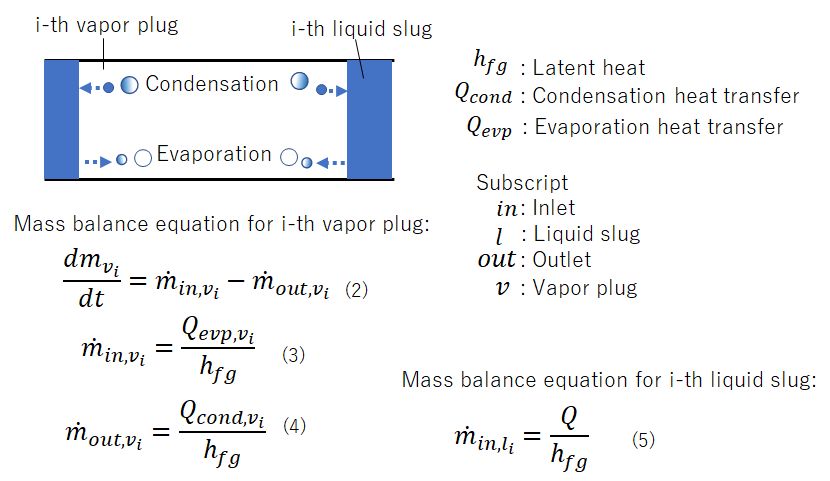 (Mass balance equation)
For
mass balance equation, first we focus on the vapor plug. The continuity
equation of the i-th vapor plug is expressed as eq.(2). The mass change of the
vapor plus is caused by evaporation and condensation from/to the liquid slug (or
a thin liquid film on a tube wall) as shown in eq. (3) and (4). The mass rate
of the i-th liquid plug can also be expressed as eq. (5).
|
Modeling of PHP #2 - momentum equation 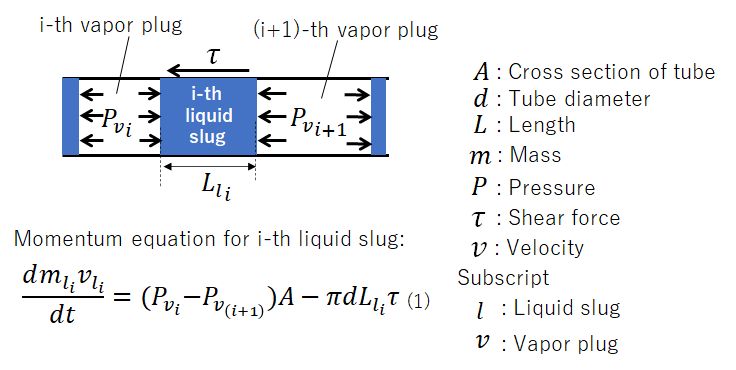 (Momentum equation of a liquid slug)
We will focus on a liquid slug. Let’s say it’s i-th
slug. It is sandwiched between i-th and (i+1)-th vapor plugs as figure shows.
The forces acting on the i-th slug are the force exerted by the vapors on both
sides and the share force caused by the friction between the liquid and the
inner wall of the tube. If the tube is installed vertically, gravity must also
be added. The momentum equation is expressed as eq. (1).
|
POTPLS Channel released a new video! 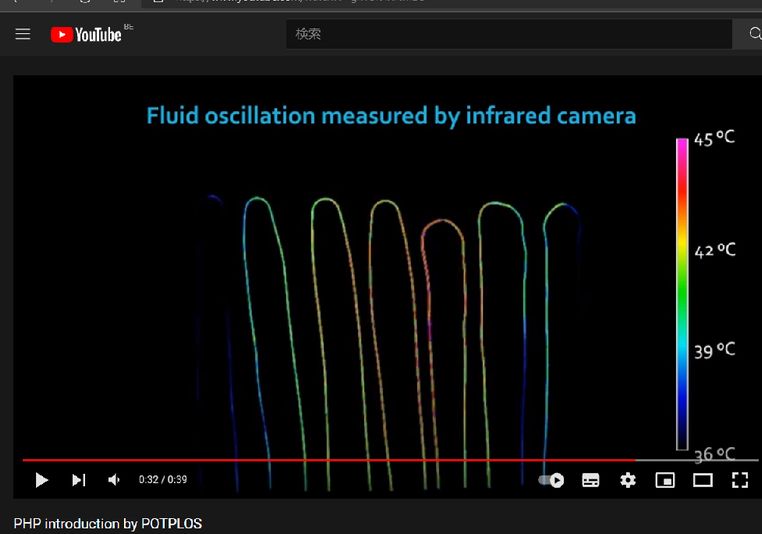 (POTPLOS Channel's new video)
A brief introduction video to heat transfer device
and PHP has been uploaded to YouTube!
https://youtu.be/ghYBK4XNMDs |
Modeling of PHP #1 - introduction 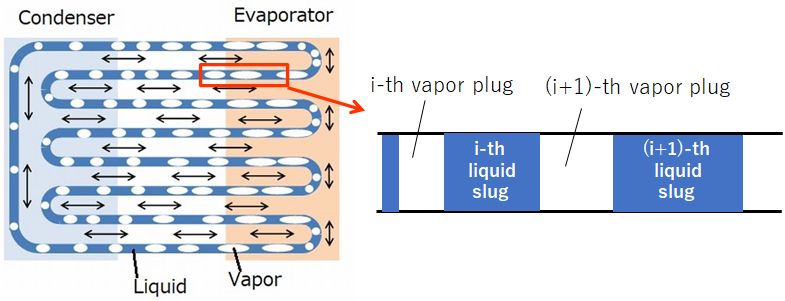 (PHP image)
Modeling of thermo-fluid behavior in PHP began to
be proposed around 1999. The model proposed by Shafii et al. in 2001 is most
widely used and became the basis for subsequent models. I’ll briefly introduce
it in over the next few posts. First, the fluid is assumed to be divided in liquid
and vapor in tubes as the image shows. A single mass of liquid and vapor is
called as a liquid slug and a vapor plug, respectively. We will number them in
order.
|
Joint 20th International Heat Pipe Conference and 14th International Heat Pipe Symposium (IHPC/IHPS 2021) 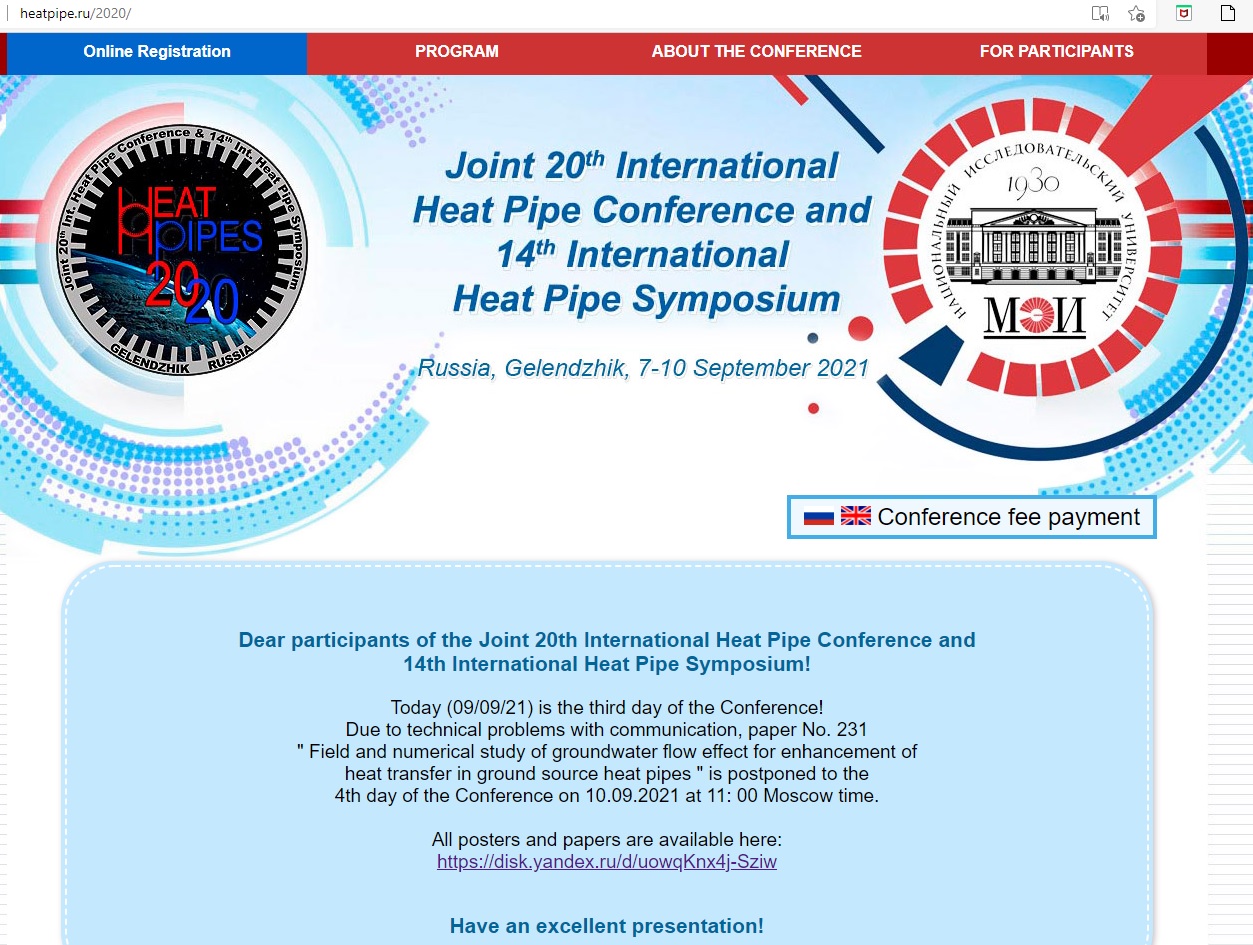 (IHPC/IHPS 2021 website)
From Tuesday, IHPC/IHPS 2021 has started. I like
this conference because I can hear the latest and interesting presentations and
discuss with the researchers in the same area from all over the world. Due to
the pandemic, most of participants are online. Today my colleagues and I both
gave presentations and got some good questions from the audience.
|
Possible PHP application #10 - flexible thermal straps 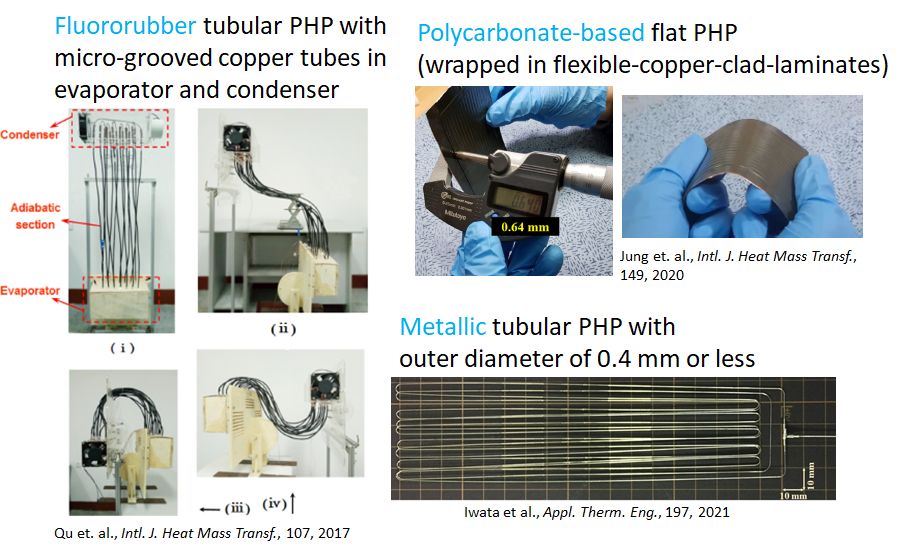 (Flexible PHPs)
A flexible thermal strap is a useful device that
combines high thermal conductivity and flexibility. So far, polymetric
materials and thin metallic tubes have been proposed for flexible PHP, e.g., fluororubber
tubular PHP with micro-grooved copper tubes in an evaporator and a condenser
(four figures on left side) and a polycarbonate-based flat PHP (two figures on
right top). Moreover, a PHP composed of metallic tubes with an outer diameter
of 0.4 mm or less has been reported.
|
Possible PHP application #9 - spacecraft 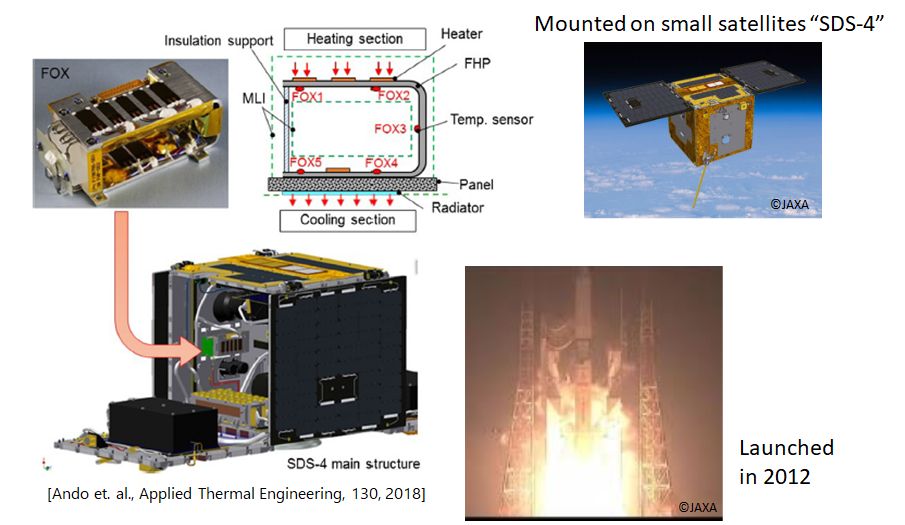 (Ando et. al., Applied Thermal Engineering, 130,
2018)
The
potential application of PHP extends beyond the ground to the space. The
lightweight PHP is suitable for space application. My colleagues of Japanese
aerospace agency successfully operated PHP on orbit. The PHP had check valves
to induce the flow from the condenser to the evaporator without gravity assist.
The PHP was mounted on a small satellite and launched in 2012. The PHP had
operated in orbit for almost four years.
|
Possible PHP application #8 - waste heat recovery system 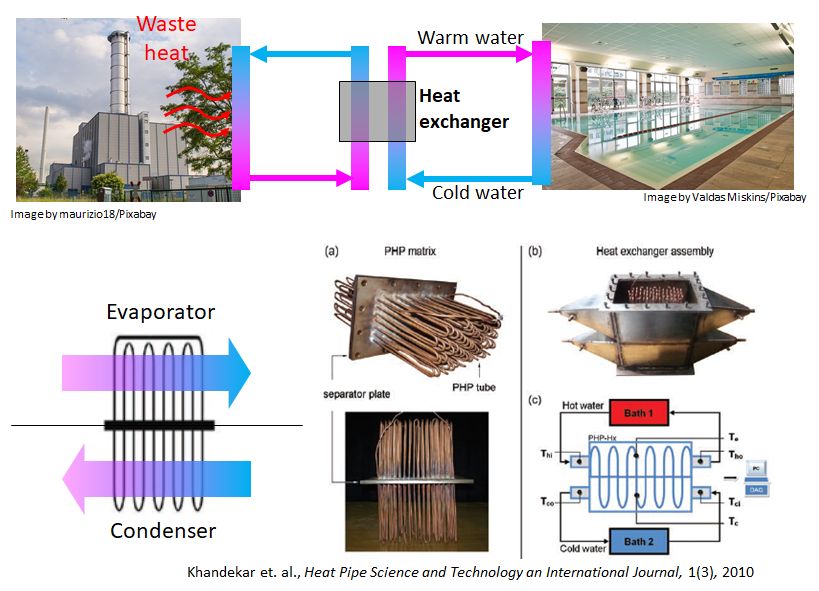 (Khandekar et. al., HPST, 1(3), 2010.)
Waste
heat recovery is an energy reuse system that uses waste heat to warm up water
or air. For example, the waste heat from the waste incineration plant can be
used to warm up the water in a swimming pool. In this system, a heat exchanger
between these two loops is essential. A PHP composed of a number of tubes has
been proposed for the heat exchanger as the image shows. The evaporator is
placed on the hot loop side and the condenser on the cold loop side, with water
or air flowing between the tubes.
|
Possible PHP application #7 - batteries 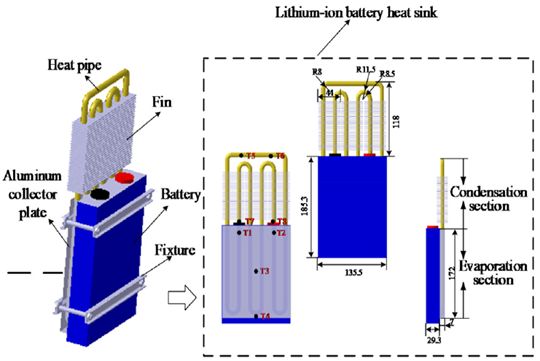 (Chen
et.al., J. Energ. Storag, 32, 2020.)
Thermal
management is very important for batteries, in particular lithium-ion
batteries. They have a narrow allowable temperature range around room
temperature. Batterie generate heat during charging and discharging cycle. If
their heat is not properly dissipated, it may cause thermal runaway and
eventually ignite. As shown in the image (Chen et.al., J. Energ. Storag,
32, 2020.), thin and wide PHP can be suitable for thermal management of
batteries.
|
Possible PHP application #6 - high temperature device 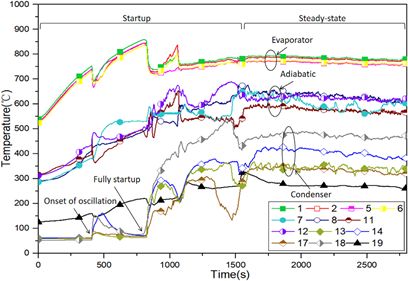 (Ji et.al., Intl. J. Heat Mass Transf.,
149, 2020.)
PHP
can be used in high temperature devices with operating temperature exceeding
500 °C. For such PHP, liquid metal
is a suitable working fluid. The image [Ji et.al., Intl. J. Heat Mass Transf.,
149, 2020.] shows the test result of a PHP filled with a sodium-potassium
alloy. The temperature history shows that the PHP starts up and operate at the
evaporator temperature around 800 °C.
|
Upload our webinar video to YouTube 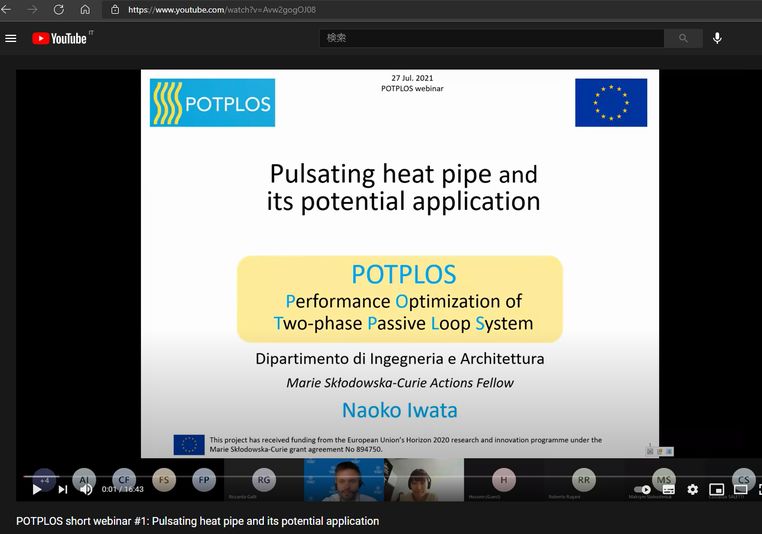 (Webinar video on YouTube)
https://www.youtube.com/watch?v=Avw2gogOJ08 Presentation file (pdf): potplos_webinar1.pdf |
Join POTPLOS short webinar! 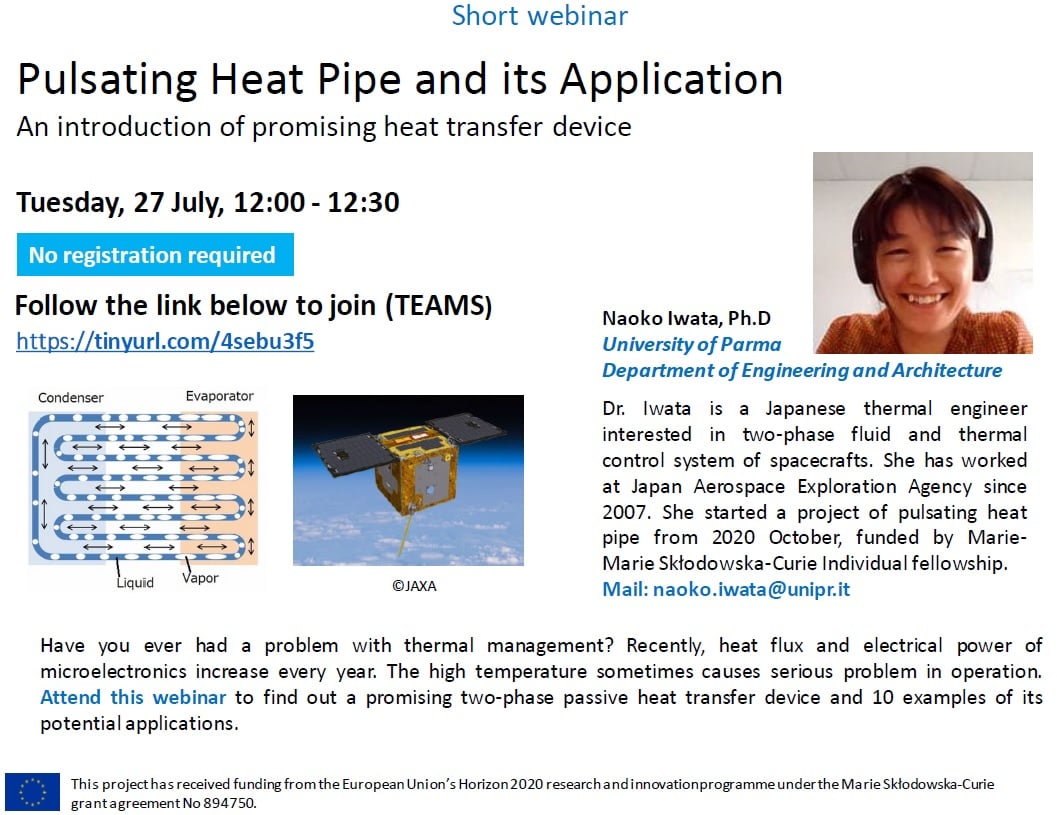 (Announcement of webinar) We will have a short webinar of PHP and its
application on 27 July at 12:00 CET. Anyone will be welcomed and be able to
watch it for free without registration. Please join from the link below
(TEAMS):
https://tinyurl.com/4sebu3f5 |
Possible PHP application #5 - cryogenic device 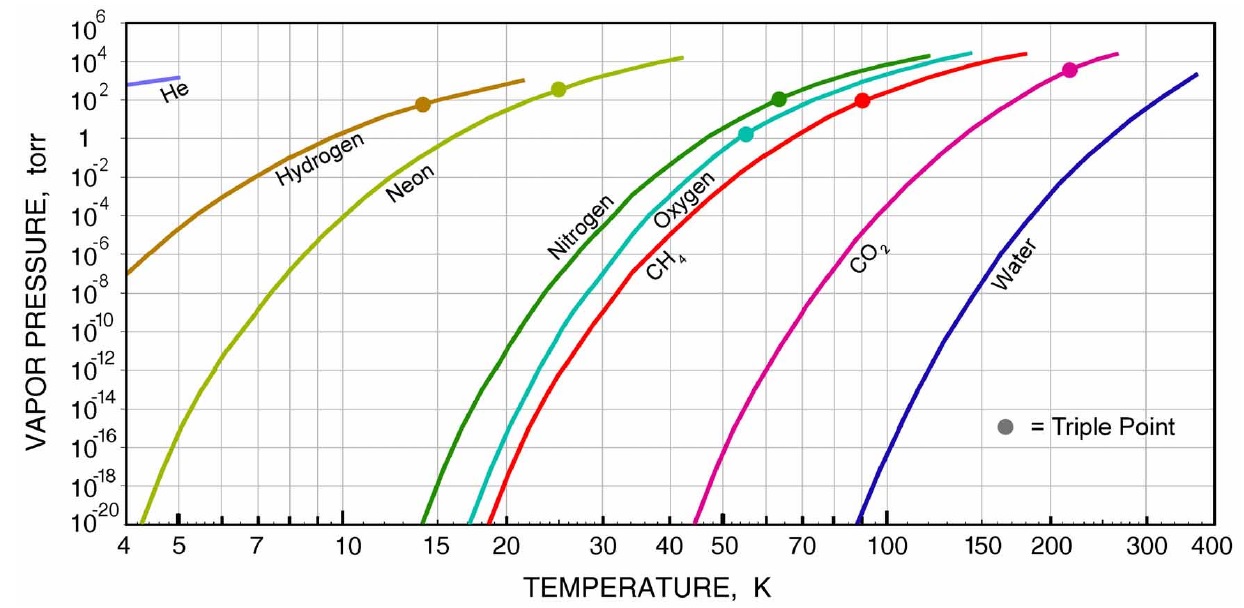 (Low
Temperature Materials and Mechanisms, Chap.6, 2016)
The
potential applications of PHP that have been introduced here so far have
generally been for devises operating at room temperature or above. PHP are,
however, also able to be used for the cryogenic devices such as superconducting
rotating machines. For the cryogenic PHP, the suitable working fluid could be
nitrogen, hydrogen, neon, and helium. These have been experimentally
investigated so far. The fluid should be determined depending on the
temperature requirement of the device.
|
Possible PHP application #4 - turbine blades 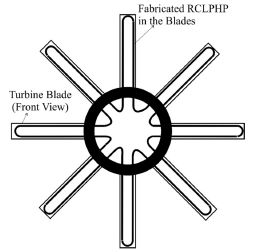 (PHP for turbine blades, [Ebrahim Dehshali et. al., 2018,) Some
studies have suggested to use a PHP to transport heat from rotating devices. The
image (Ebrahimi Dehshali et.al., 2018) shows a PHP integrated in turbine blades
(test model). The PHP thermal performance could be improved if the centrifugal
force drives the flow of the working fluid from the condenser to the
evaporator. Ebrahimi Dehshali et.al. reported that the thermal resistance
decreased when the rotation speed was increased from 200 rpm to 800 rpm.
|
Possible PHP application #3 - solar water heating 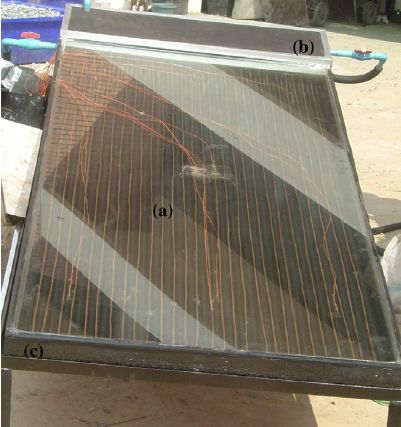 (PHP for solar water heating, [Rittidech and Wannapakne, 2007]) The
image (Rittidech and Wannapakne, 2007) shows a PHP tested for solar water
heating (solar collector). In general, the solar water heating requires a large
heat transfer area. This means that PHP is suitable to use. The PHP has a
2m-long-evaporator (a) and a 0.5m-long-condenser water tank (b). The tests in
sunlight have shown a cumulative collect efficiency of 62 %.
|
Possible PHP application #2 - mobile PC 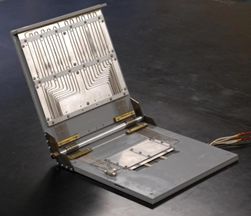 (PHP for mobile PC - test model [Miyazaki, 2005]) The
image shows (Miyazaki, 2005) shows a test model of a flexible PHP integrated to a
mobile PC. The PHP functions to transport heat from the CPU to the rear surface
of the folding display, which serves as a radiating surface. The tubes at the
hinge are flexible so that the PHP can be fold.
|
Presentation at conference 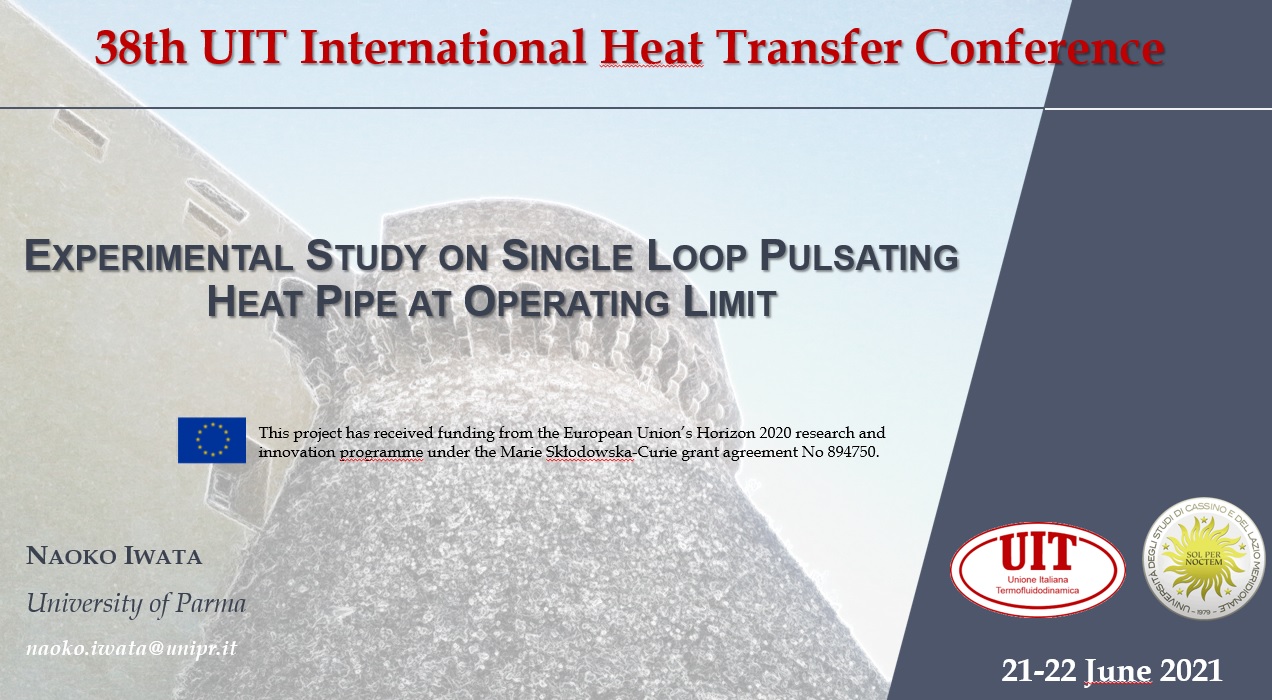 (presentation at UIT conference) The
image shows the first slide of my presentation. The conference was held online
due to the pandemic. It’s been two years since I presented at a conference and
this was the first time I attend an online one. As a presenter, I’m less
nervous online, but it’s much better to attend in person to communicate with
the participating researchers.
|
Possible PHP application #1 - electronics 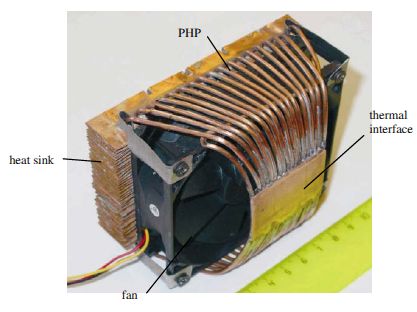 (poposed application of PHP for cooling electronics ) Over
the next few posts we will show some of the possible applications proposed in
the previous studies. The image (Maydanik et al., 2009) shows a PHP for the
cooling an electronics device. The heat generated by the device is transferred by
the PHP to the heat sink, which is cooled by a fan; thanks to the PHP and the
heat sink, the heat transfer area increases and the device can be cooled more
efficiently.
|
Why modeling is necessary? 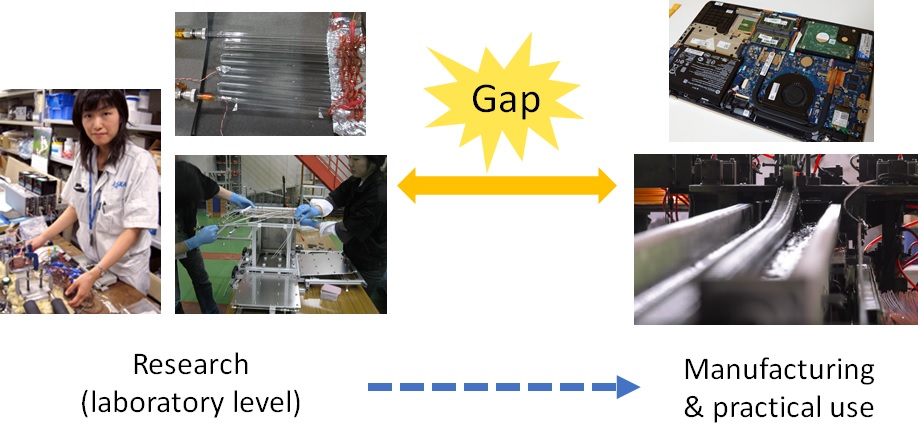 (gap between research and practical usel) Although
PHP is a promising heat transfer device with a lot of advantages, it has not
yet been put to practical use and is still at the level of laboratory-scale
experimental study. We think that the lack of the design tool is one of the
reasons. By providing a model to predict performance, we hope to make it easier
to design PHP.
|
POTPLOS goal  (Illustration of goal) We aim
to provide a more complete picture of the termination mechanism of the
self-oscillation of vapor and liquid, i.e. operating limit of PHP. We think
that there are multiple mechanisms which leads PHP to its operating limit, and
that they vary depending on the configuration or conditions of PHP. Our goal is
to establish a predictive model and show the optimum design solution to
maximize heat transport.
|
What discrepancy is there? 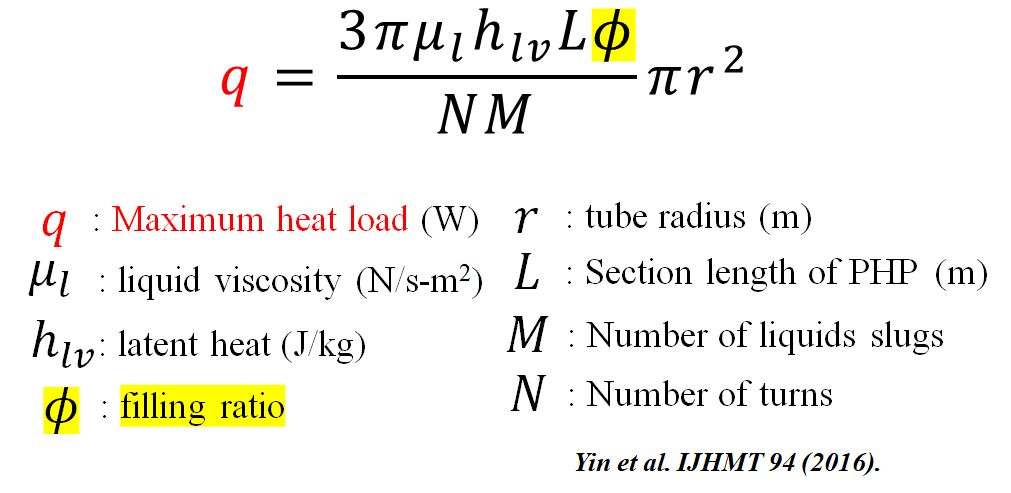 (Equation to predict maximum heat load) Yin et
al. expressed the heat load at the operating limit as follows. From this
equation, the higher the filling ratio, the larger the maximum heat load. They
validated their simulation with the experimental results. In general, however,
the optimum filling ratio is around 50 % in terms of the operating limit.
|
Transition of flow pattern 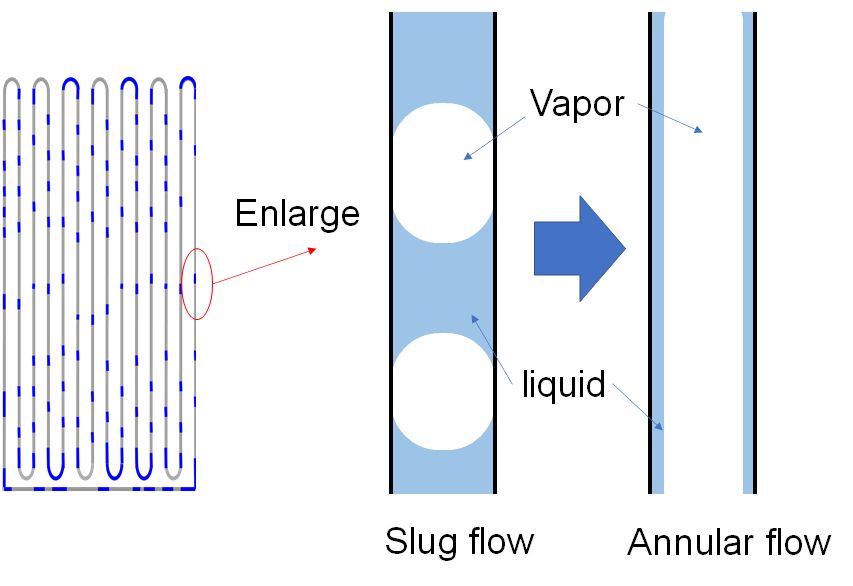 (Transition of flow pattern) Some
visualization tests show the transition of the PHP flow pattern along with
increase of the heat input to the evaporator: from slug flow to annular flow.
Yin et al. [Int. J. Heat Mass Trans.,2016] proposed that this transition causes
the operating limit and presented a mathematical model. However, there are some
discrepancies with the results of other studies.
|
Dry-out? 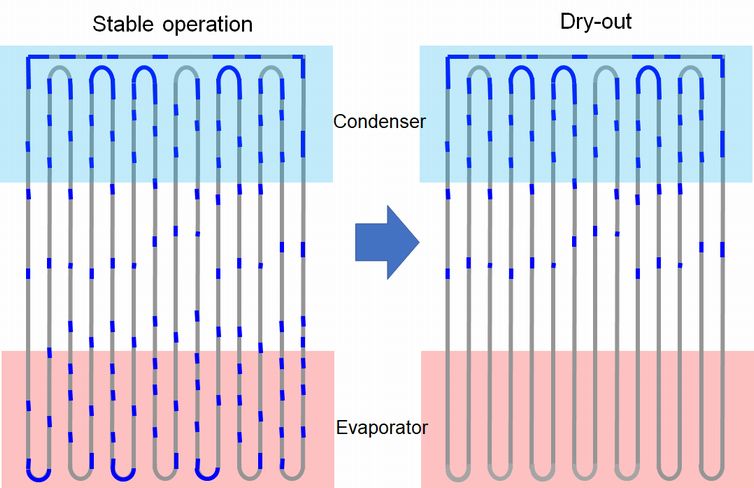 (Stable operation and dry-out) Why does
the PHP reach operating limit? One possible phenomenon is a dry-out. Generally,
this means that the evaporator dries out and that the fluids no longer exists there
in case of large amount of heat input. It is well known and the word dry-out is
sometimes used instead of the operating limit. However, is dry-out the only
phenomenon that leads the operating limit?
|
Influencing factors on maximum heat transfer rate (Qmax) 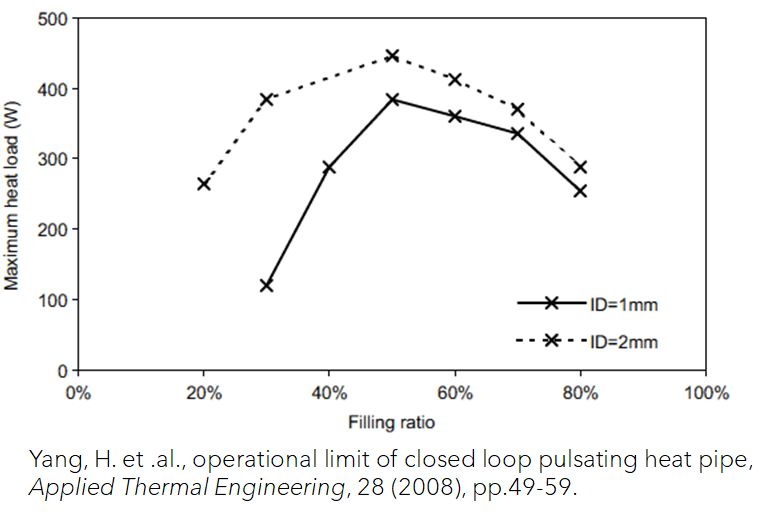 (Relation between Qmax and filling ratio) Generally,
the optimum filling ratio that maximizes Qmax is around 50 %. Several studies
have reported the larger the tube (or channel) diameter is, the greater the
Qmax (note that the diameter should be smaller than the critical diameter).
This is because the heat transfer area becomes large. For the same reason,
increasing the number of turns also leads an increase in Qmax.
|
Maximum heat transfer rate 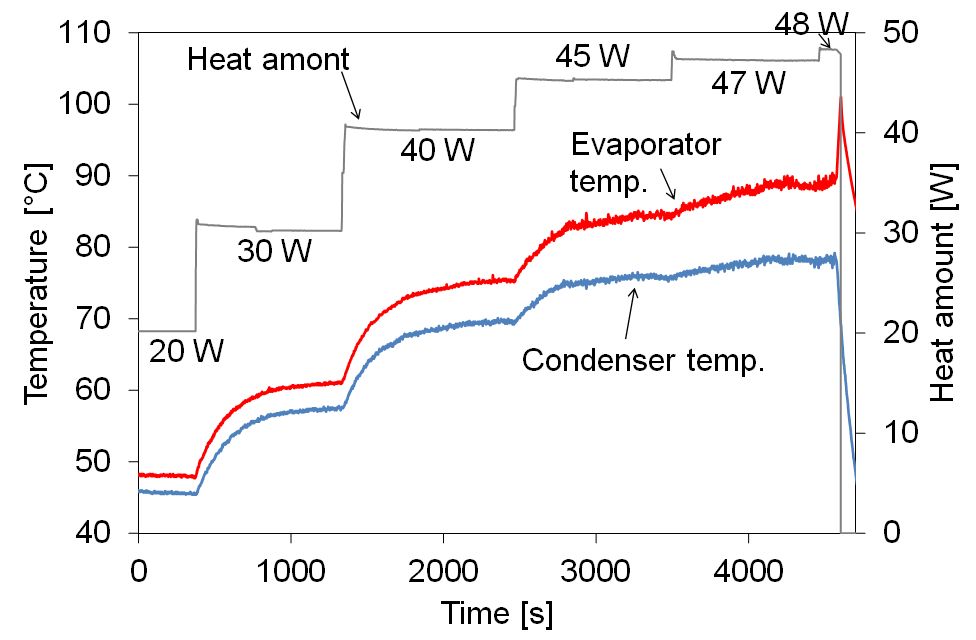 (Temperature and heat input history until PHP reaches operating limit)
The PHP
thermal performance is also evaluated by the maximum heat transfer rate
(Q_max). Generally, it corresponds to the heat amount in which PHP stably
operates just before its operating limit. The image shows the temperature and
heat input history. The heat input to the evaporator is increased by stepwise.
The PHP reaches the operating limit at the heat input of 48 W. In this case,
Q_max is around 47 W.
|
Unsolverd issue on thermal resistance 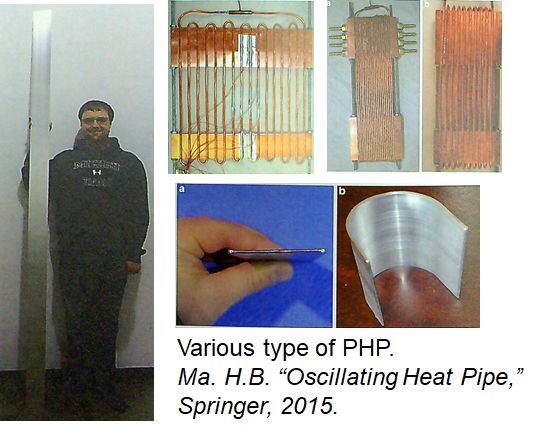 (Various type of PHP by "Oscillating Heat Pipe," Ma, 2015.) 09 Apr. 2021
The numerous
experimental studies have measured the thermal resistances of various PHPs so
far. However, it is still difficult to predict the resistance exactly without
testing the actual PHP.
|
Thermal resistance #2 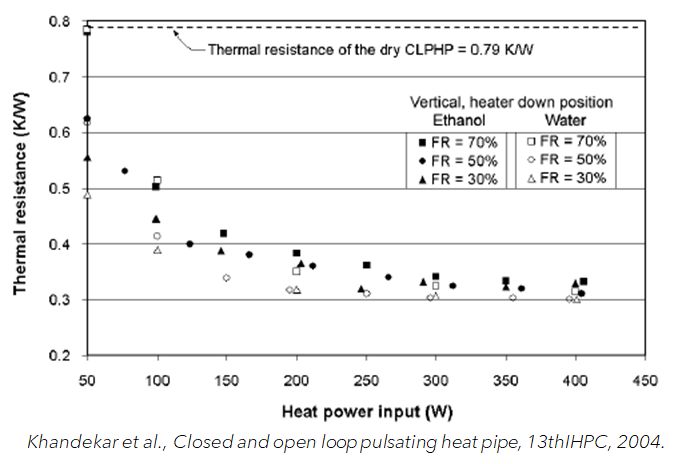 (Khandekar et al., Closed and open loop pulsating heat pipe, 13thIHPC, 2004.) 03 Apr. 2021
Thermal
resistance of PHP varies depending on the PHP configuration, the type of the
working fluid, and filling ratio (FR). Also, the resistance may change
depending on the heat input to the evaporator, as shown in the image.
|
Thermal resistance #1 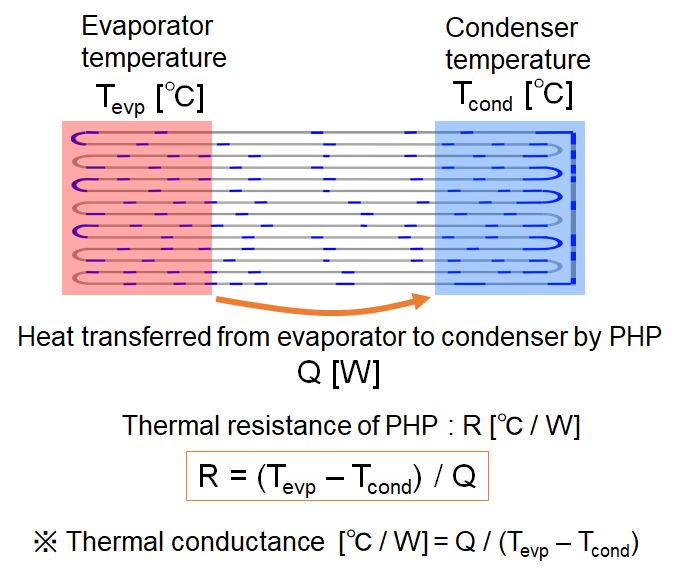 (Thermal resistance) 29 Mar. 2021
Generally,
the thermal performance of PHP is evaluated by the thermal resistance defined
with the equation shown in image or the thermal conductance, the reciprocal of
the resistance. The smaller the resistance, the higher the performance, because
it means that the PHP transfers the heat with a small temperature difference
between the heating section (evaporator) and cooling section (condenser).
|
What does happen after operating limit? 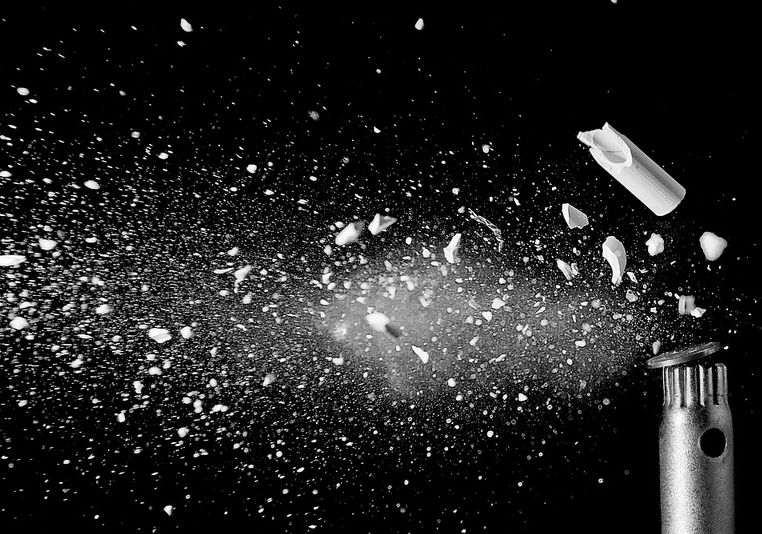 Explosion (Photo: Ralf Vetterle/Pixabay) 18 Mar. 2021
If the
heat input to the evaporator continues after the operating limit is reached,
the evaporator temperature rises immediately and the internal pressure of the PHP
also increases. In the worst case, this destroys the PHP. In addition, the
equipment cooled by the PHP heats up due to the lack of heat transfer, which
may cause serious damage to the equipment. (The image is for illustration
purpose.)
|
Operating limit  (Temperature history before and during dryout) 10 Mar. 2021
Same
as other type of heat pipes, PHP cannot transfer infinity large amount of heat.
It has a limitation. Increasing the heat input step-wisely, at the end you will
find the evaporator temperature suddenly rises, while the condenser one drops
simultaneously. It indicates that PHP reaches its operating limit. The generated
heat is no longer transferred from the evaporator to the condenser, which cause
the rapid change of both temperatures.
|
Stepwise heat-up  (PHP temperature history during start-up) 05 Mar. 2021
After
PHP start-up, increase heat load amount gradually. We often conduct this kind
of stepwise heat-up test to evaluate the heat transfer performance during its
stable operation. As you see the image, the evaporator and condenser
temperatures increase along with the increment of heat input and they fluctuate
due to the fluid self-oscillation.
|
PHP start-up 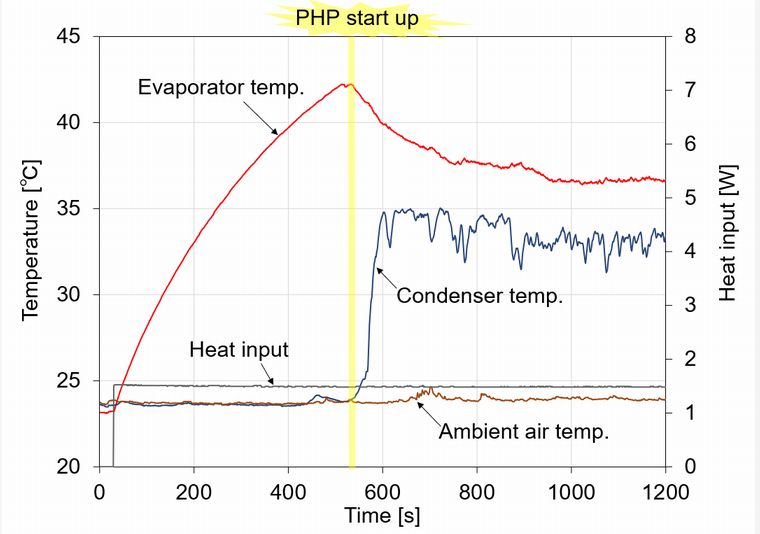 (PHP temperature history during start-up) 24 Feb. 2021
The image shows a typical
temperature history during PHP start-up. Before start-up, the evaporator
temperature rises, while the condenser is kept at ambient air temperature.
Suddenly the evaporator temperature decreases and almost simultaneously the
condenser temperature increases. It indicates the fluid in PHP starts to
oscillation.
|
Communication at ITIS E. Fermi 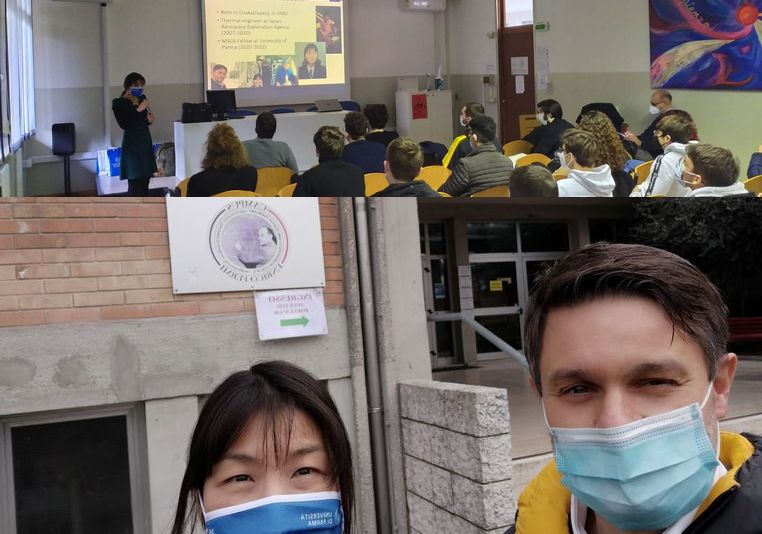 (Communication activity at ITIS E.Fermi) 17 Feb. 2021
Fabio
and Naoko enjoyed the presentation at ITIS E.Fermi Mantova. The students actively asked
us questions during and even after the presentation. It was my great pleasure
to communicate with young Italian students about our project and Japanese
culture. Thank you for inviting us!
|
Instituto Fermi 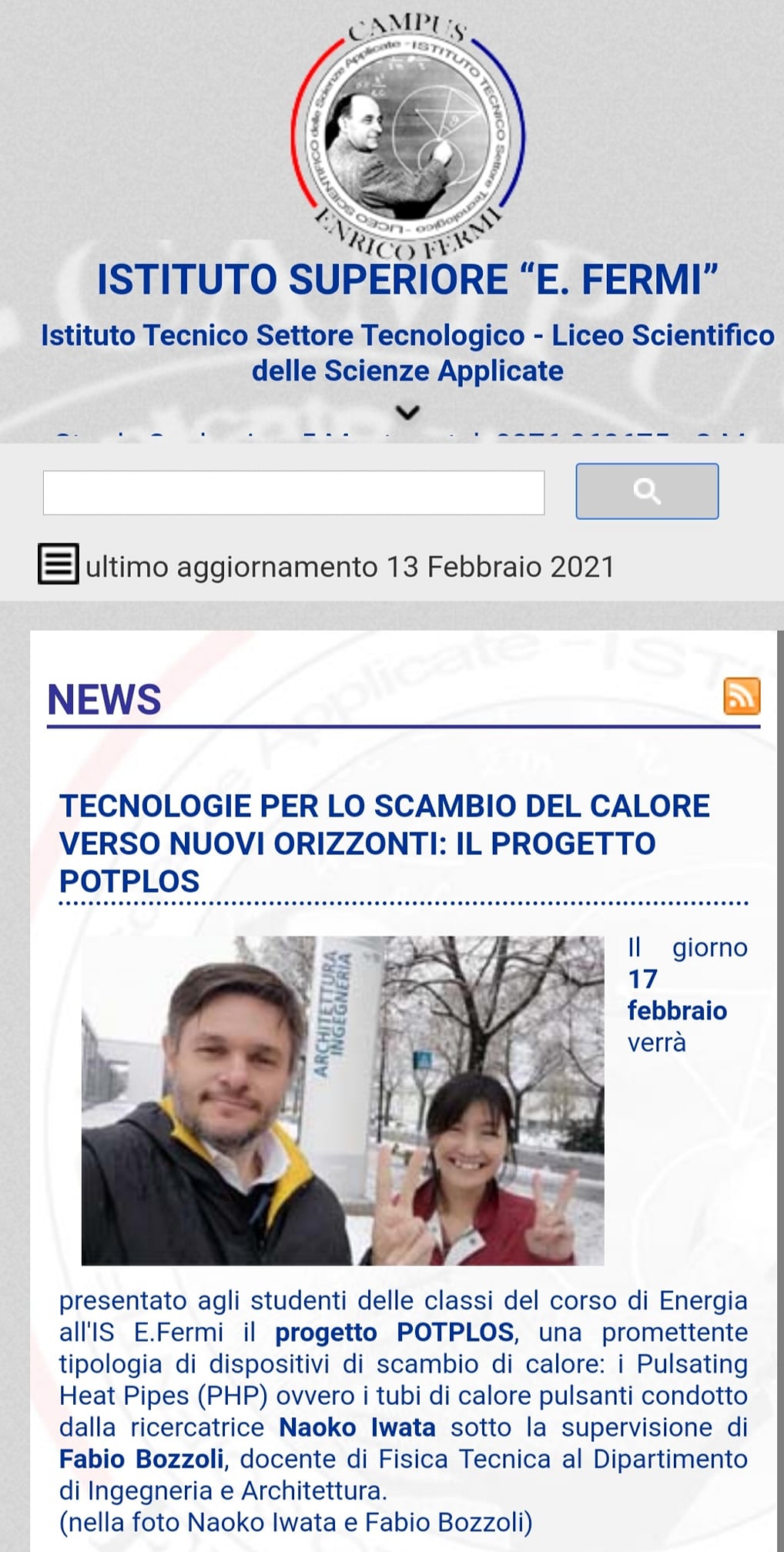 16 Feb. 2021
Tomorrow we will talk about POTPLOS with students of ITIS E.Fermi Mantova .
It iwill be a challenging joy. 🥳💪🙃 Thanks to Marianna Pavesi for the invitation. |
Bottom heat 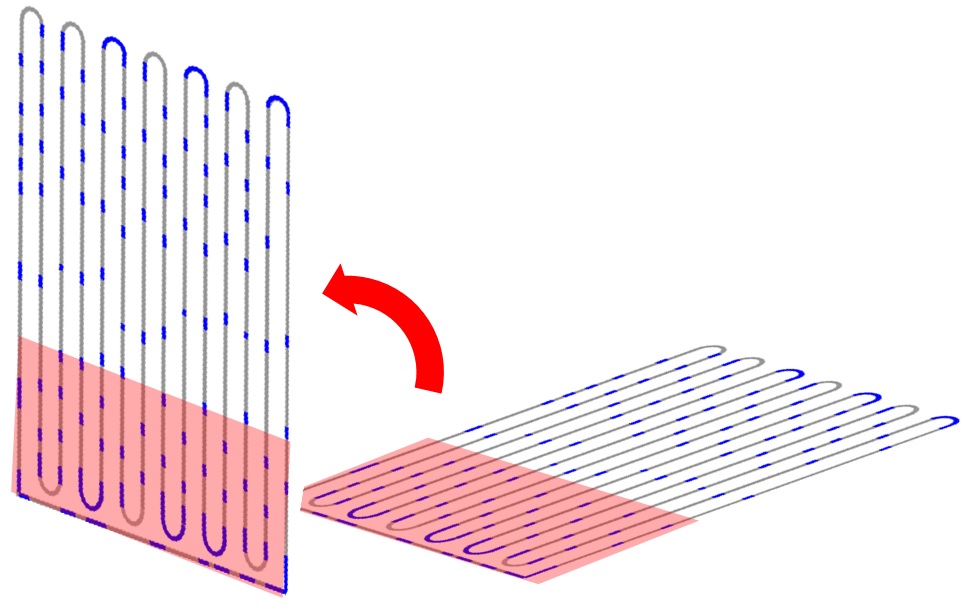 (PHP in horizontal and vertical position) 14 Feb. 2021
The
inclination angle strongly affects PHP’s heat transfer performance. Sometimes
PHP doesn’t work at horizontal position. Generally, PHP in a vertical position
with a heated bottom works better. The liquid that condensed in the upper part
easily returns to the bottom (evaporator) by gravity assist. It doesn’t work if
the top is heated because the liquid has to flow toward the evaporator against
gravity.
|
How to cause self-oscillation?  (Heater attachement to PHP) 03 Feb. 2021
Warm
up one end of PHP to cause the fluid oscillation. PHP doesn’t work if it has no
temperature gradient. Wound a wire heater around tubes, or attach a sheet
heater on the metal plate which is bonded to tubes by a tape. If you don’t have
any heaters, warm it up by touching your hand. It can cause the oscillation,
but it depends on the fluids.
|
Fluid charging 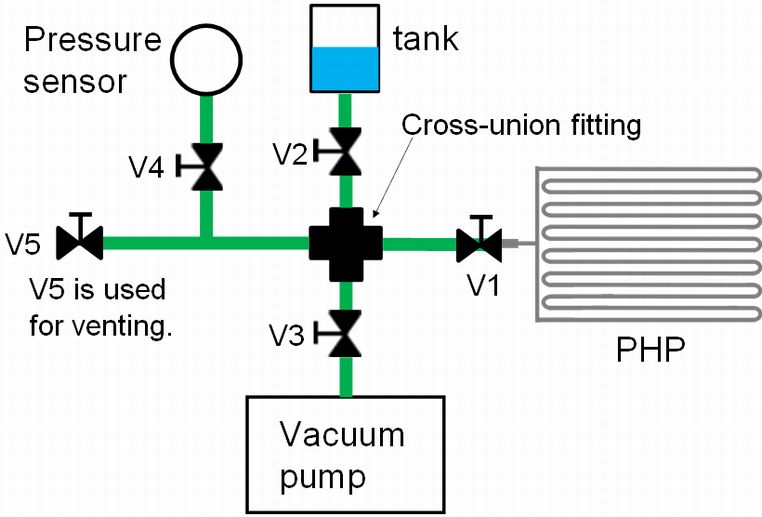 (simple charging system) 29 Jan. 2021
One Charging
PHP with fluid requires a bit of hard effort and devices. The image shows a
simple charging system. The goal is to fulfil the inside of PHP with the two-phase
fluids only. First, evacuate it by vacuum pump (open V1&V3&V4, close
the others), and then induce the fluid from tank (open V1&V2(&V4), close
the others). Cooling PHP or warming tank help charging.
|
Let's make a PHP  ( PHP under making (left) and completed one) 22 Jan. 2021
One of
the attractive points of PHP is a simple structure. All you need is a tube, a
T-shape joint, and a valve. The image shows a metal tube, but you can also use
plastic tubes (please check the maximum design pressure and compatibility with
the fluid). Prepare a long tube, and bend it in two directions many times. Finally,
join both ends to T-joint, along with another tube connected to the valve.
|
Japanese engineer who invented PHP 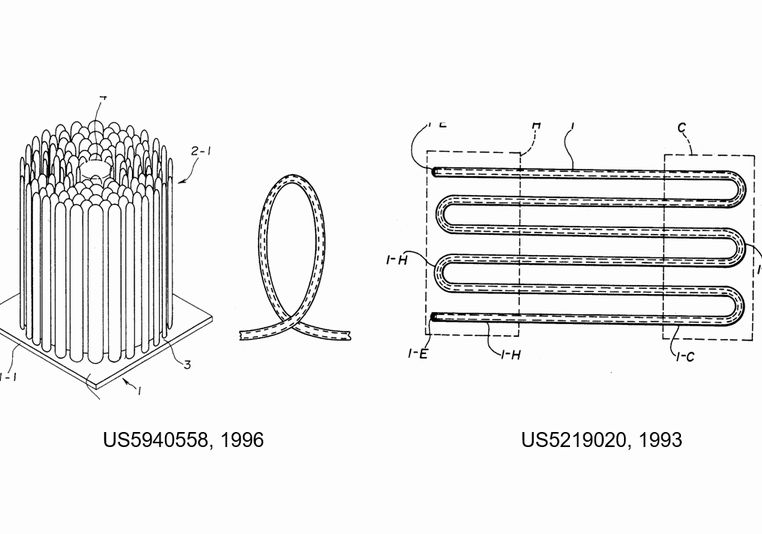 (Figures from Mr. Akachi's patent)
13 Jan. 2021
PHP was
invented by a Japanese engineer, Hisateru Akachi. He obtained the U.S. patent
as “micro heat-pipe” or just “heat pipe” (see images) and then presented it as
“pulsating heat pipe” at an international conference in 1996. It’s a shame that
he already passed away and that I’ve never met him though I worked close to the
company that he used to work for.
|
Closed loop v.s. open loop 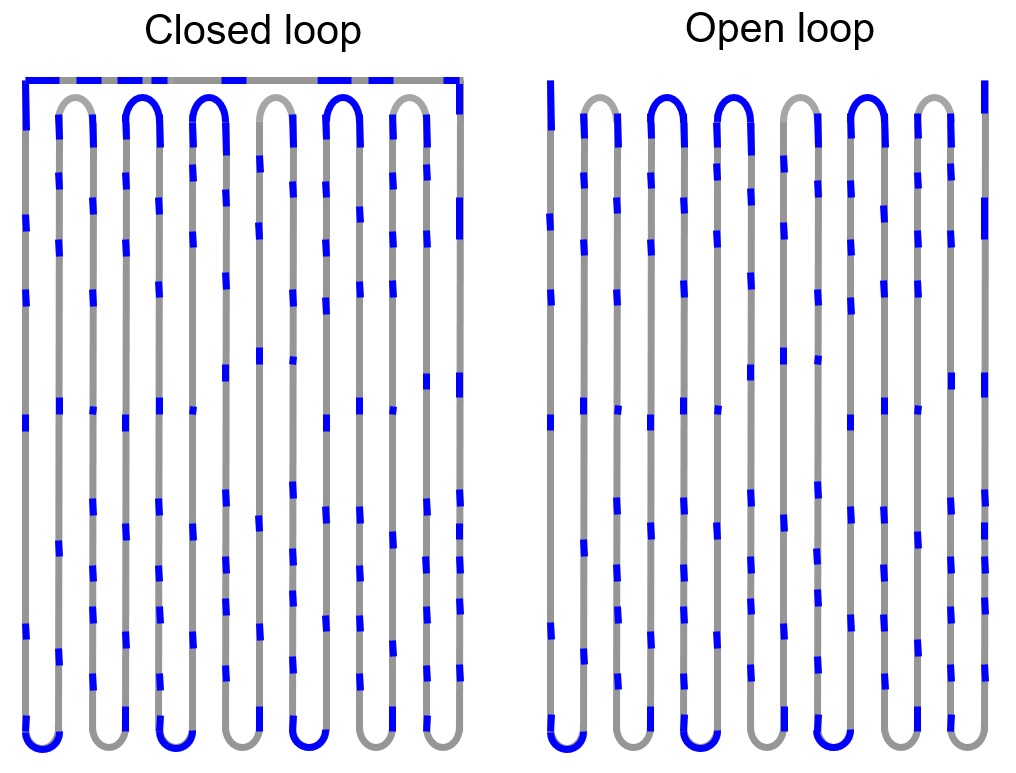 (Closed loop and open loop PHP)
07 Jan. 2021
Which PHP do you think has better heat transport
performance, closed or open loop? When the PHP researches began to widely
spread, some researchers studied about it. It was reported [e.g. Khandekar.
2004] that closed loop PHP has better performance since the fluid can circulate
and the velocity is faster than the opened one. Nowadays, the closed loop is
commonly used for the research.
|
Small tube is required for PHP 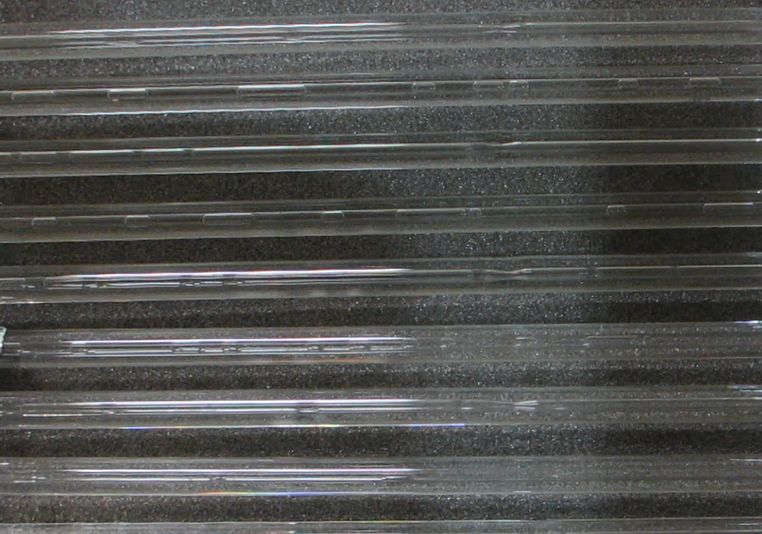 (Vapor and liquid in glass PHP)
28 Dec. 2020
The liquid
and vapor must be separated into “crushes” in the PHP as shown in the image in
order to cause self-excited oscillation. It means the inner diameter of the PHP
tube must be small enough to allow the entire circumference of the inner wall to
get wet with the liquid due to the surface tension even in a gravitational environement.
|
| Merry
Christmas! (PHP-like
Christmas tree!)
|
How
does liquid move in PHP? 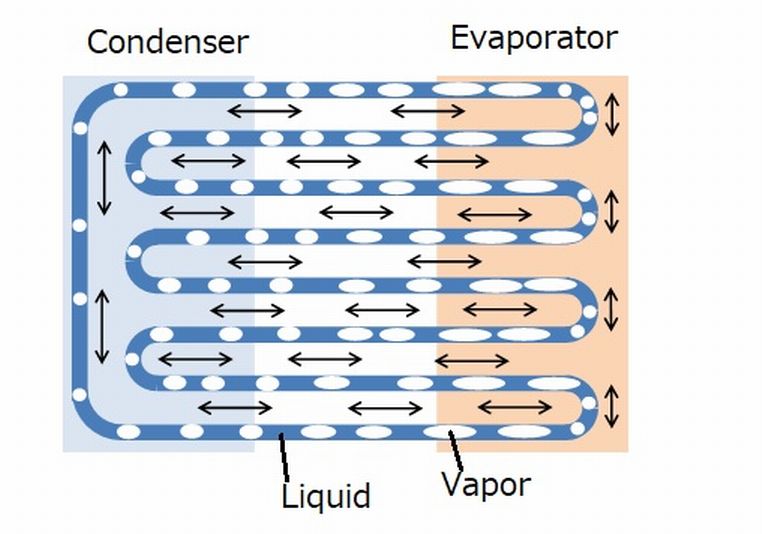 (Schematic
of PHP)
24 Dec. 2020
Inside the
PHP, the liquid and vapor exist separately
as the above image shows. When one end of PHP is heated (it is defined
as an
“evaporator”) and the other is cooled (“condenser”), the vapor and
liquid start
to oscillate spontaneously between the two ends due to pressure
gradient
induced by temperature gradient and phase change phenomena.
|
|
Pulsating
heat pipe
 (Pulsating
heat pipe)
21
Dec. 2020
Pulsating
heat pipes (PHP), so-called oscillating heat pipes are quite different
from the
(conventional) heat pipes while both contain two-phase fluids (vapor
and
liquid). PHP consists of thin pipes meandering in two directions as the
image
shows. The key difference is lack of wick. In PHP, the liquid is able
to move
without capillary force of wick.
|
Pros
and cons
of heat pipe 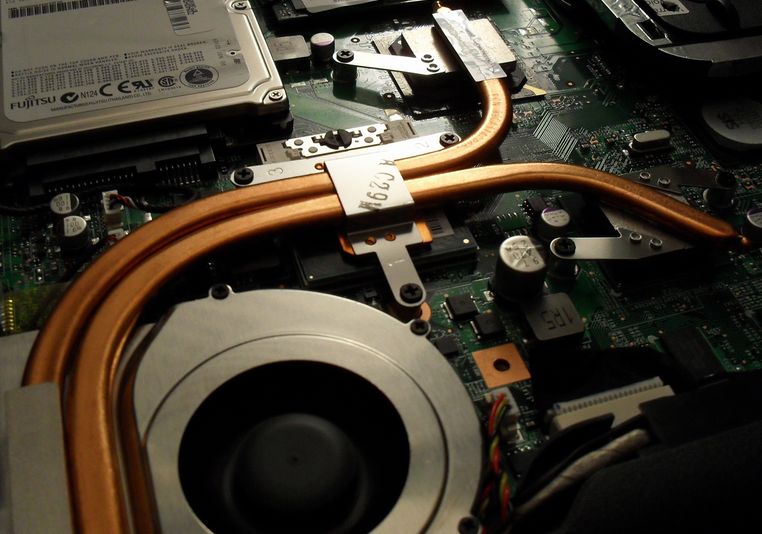 (Overview
of Grover's heat transfer device, cited from U.S. Patent No.3229757)
09 Dec. 2020The
first
idea for heat pipe was patented by Gaugler in U.S. in 1942, but it was
not put
to practical use. About 20 years later, Grover invented a heat pipe
(see above)
independently of him and
succeeded in putting it to practical use. First the heat pipe was
developed for
aerospace application. The first satellite where the heat pipes were
mounted was launched in 1967. It has also become widely used for
terrestorial application after being commercialized.
|
History
of heat pipe 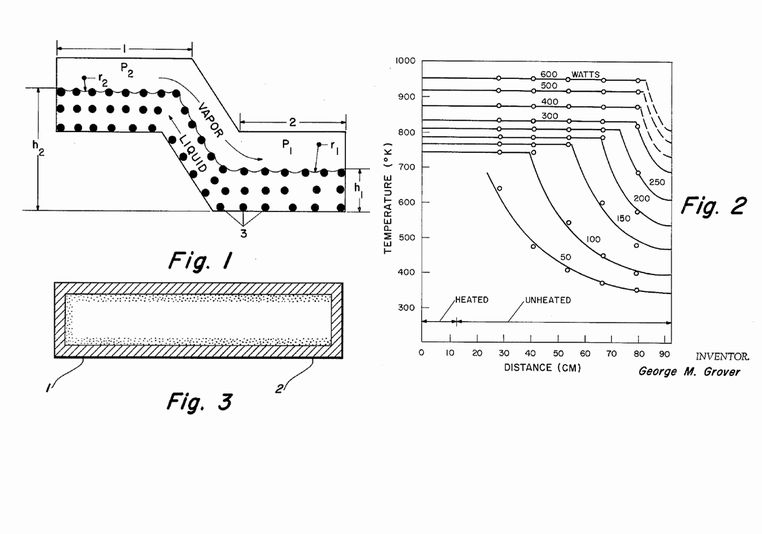 (Overview
of Grover's heat transfer device, cited from U.S. Patent No.3229757)
09 Dec. 2020The
first
idea for heat pipe was patented by Gaugler in U.S. in 1942, but it was
not put
to practical use. About 20 years later, Grover invented a heat pipe
(see above)
independently of him and
succeeded in putting it to practical use. First the heat pipe was
developed for
aerospace application. The first satellite where the heat pipes were
mounted was launched in 1967. It has also become widely used for
terrestorial application after being commercialized.
|
How
does fluid move in heat pipe? 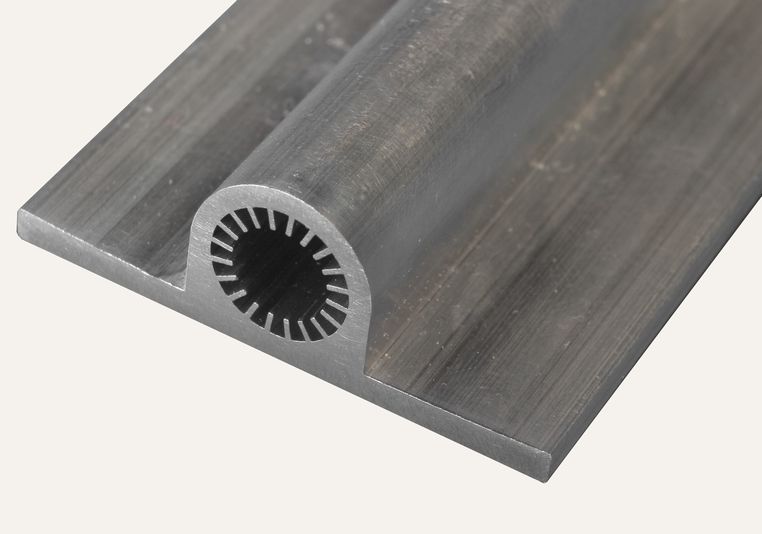 (Cross section of heat pipe, photo by BillAnderson71 - Own work, CC BY-SA 3.0, https://commons.wikimedia.org/w/index.php?curid=32084199) The
condensed
fluid inside a heat pipe should move from the cooled part to the heated
one,
otherwise the heated part dries out. The gravity assists it on the
ground, but
in space it is impossible. Then what should we do? – An answer is a
capillary
force. The image shows a cross section of a typical heat pipe. The
grooves on the
wall are for carrying liquid by capillary force.
|
What
is a benefit of two-phase device? 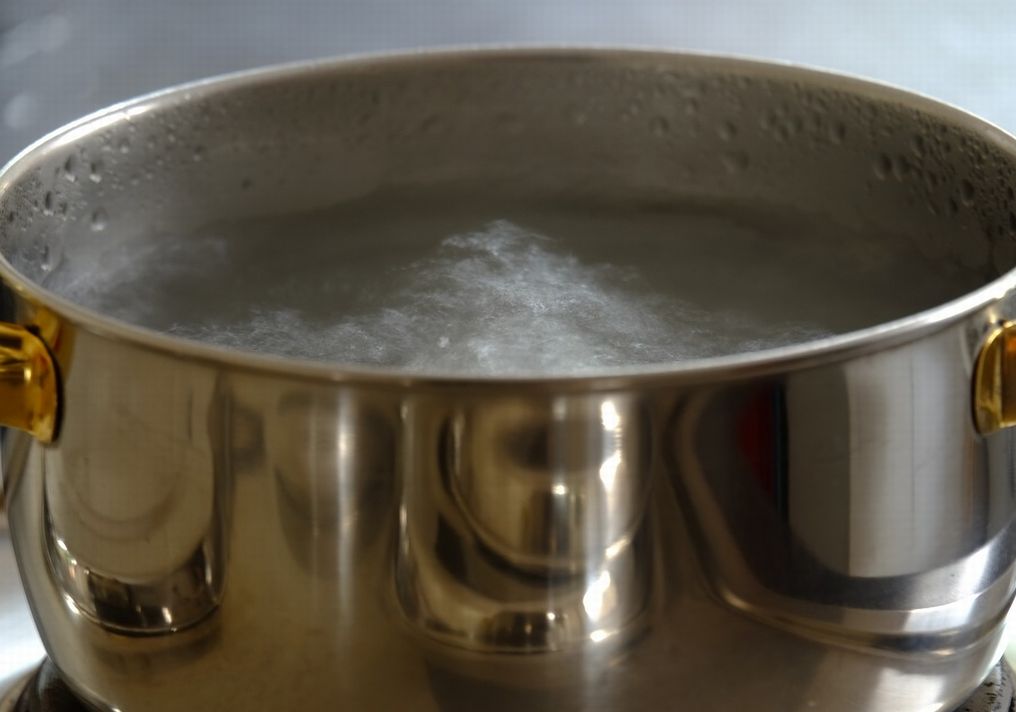 (Vapor and liquid, photo by Holger Schuč/Pixabay) 04 Dec. 2020
The image illustrates water in a two-phase state (vapor and liquid). Two-phase fluid devices that contains a fluid in this state are more efficient than single-phase ones because some or all of the heat transport occurs via latent heat. The fluid in the device evaporates at the heated part and condensates at the cooled part. Thanks to the phase-change phenomenon, the heat is transported between the two parts without a large temperature drop. |
Why
is a heat tranfer deivce needed? 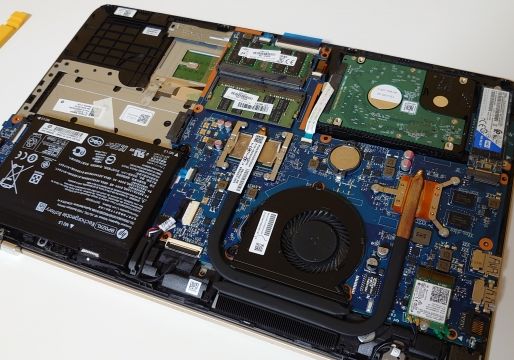 (Inside of laptop computer, photo by PhotoAC#4113586) The
above image shows inside of a laptop computer. Two flat pipes around a
fan
transport heat generated by two electrical parts. The parts are not
always
placed close to the cooling system (e.g. fan) due to the layout
constraint.
Therefore, the heat must be transported from the parts to the cooling
fan by a heat
transfer device. The device is required to have a high heat
conductivity because
it is essential to transfer the heat without large temperature
drop.
|
Thermal
management is crusial 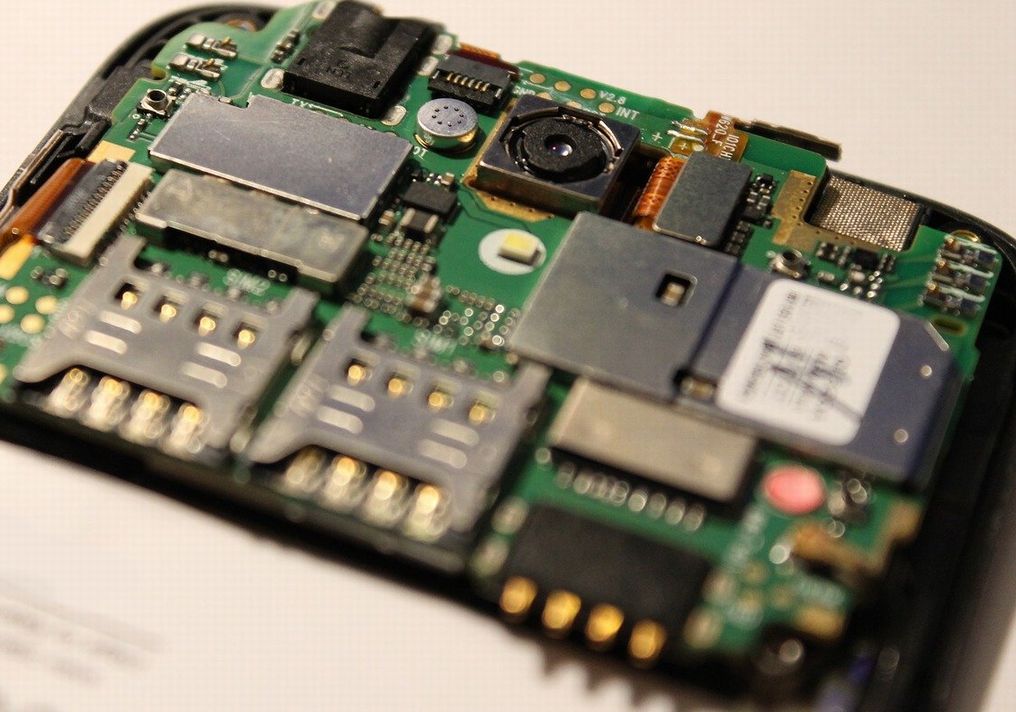 (inside of a smartphone, photo by FlitsArt/Pixabay) This
is an image of electronic board inside the smartphone. You can see a
lot of
parts are arranged in a narrow space. The heat flux of heat-generating
parts
become high and it causes a high operating temperature. It often
reduces the
reliability and performance of electronics, and eventually causes fatal
failure. Thus, the thermal management of complex electronic systems has
become
an important challenge.
|